- Grades 6-12
- School Leaders
Don’t Miss Our List of the Top 2024-25 Competitions for Students in Grades K-12! 🏆

20 One-Pager Examples, Plus Advice for Using Them With Your Students
A single page of notes can be a real game-changer.
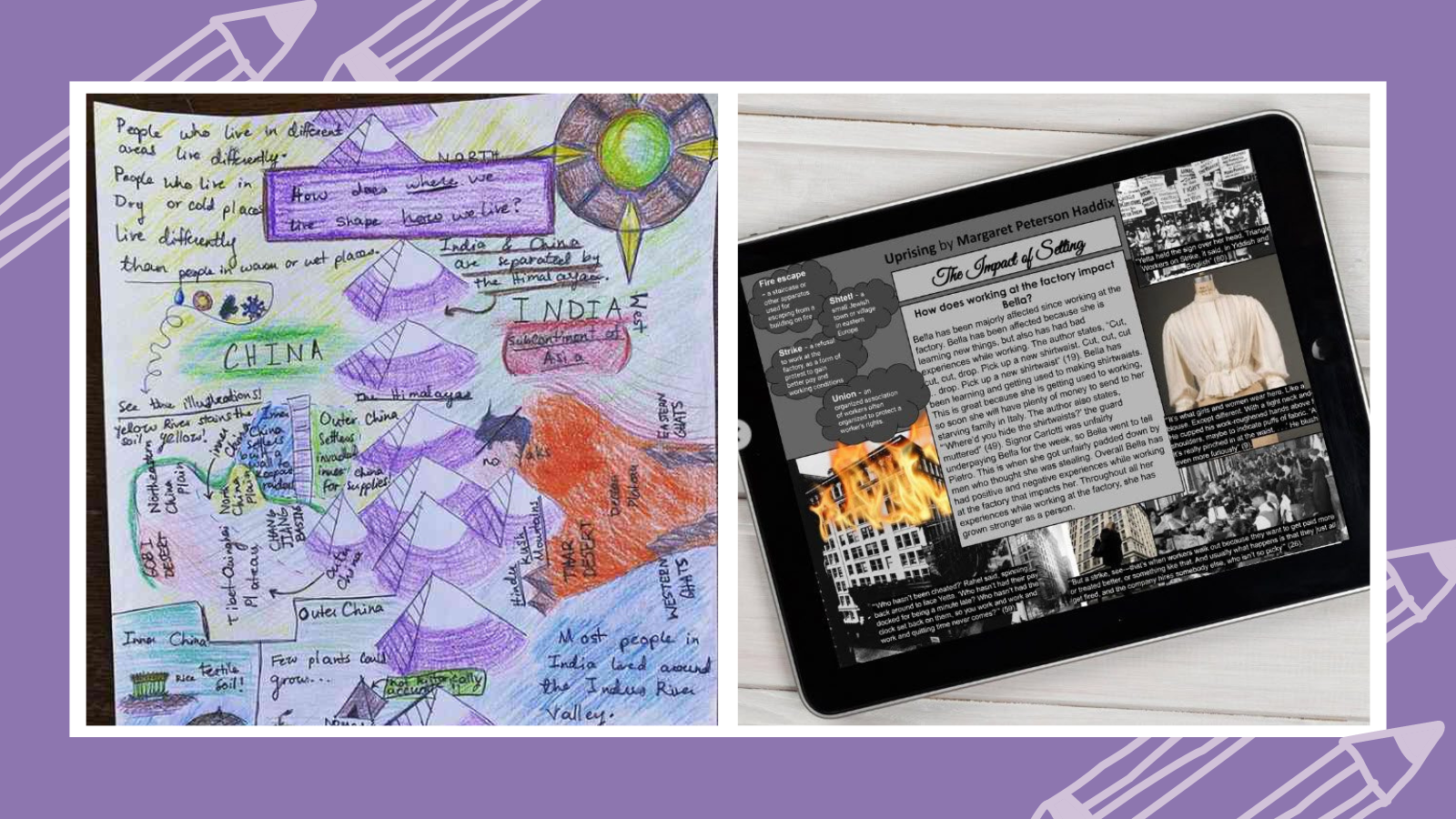
One-pagers and Sketchnotes have become incredibly popular in recent years, and it’s easy to see why. Rather than just jotting down words on a page, students use one-pagers to visually represent key points and takeaways. They’re fun to create and have a real impact on memory and comprehension. Here’s how to use them, plus lots of terrific one-pager examples to inspire you and your students.
What Are One-Pagers?

One-pagers invite students to think deeply about a text and produce a single page to represent its most important aspects. They usually include some images, doodles, or other graphic elements, giving them the alternate name Sketchnotes . One-pagers are often full of color and may include more images than words, depending on the student. They’re most commonly used in ELA classrooms but can be helpful in other subjects too.
This note-taking concept was pioneered by AVID , a group that seeks to prepare all students for college. As one-pagers caught on, teachers found that students who used one-pagers made a deeper connection to the text and had better retention of key concepts. AVID’s guidelines encourage students to share their one-pagers with one another, helping to inspire learning in a variety of visual ways.
How To Get Started With One-Pagers
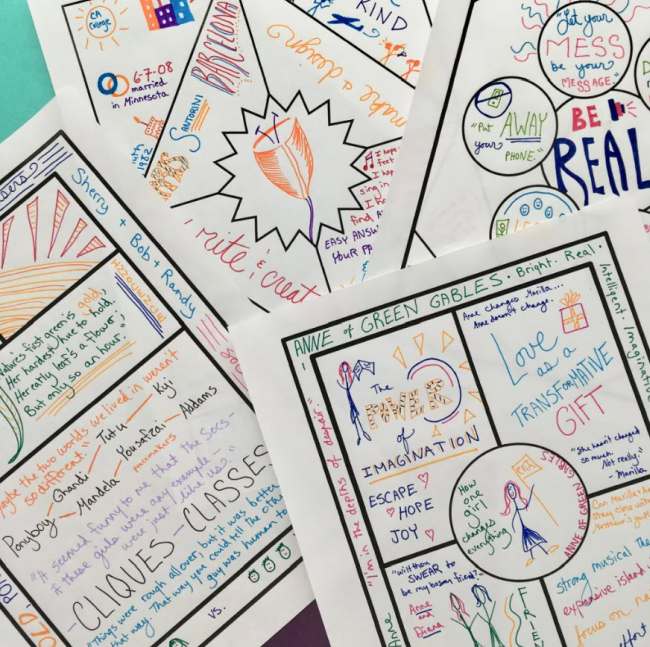
One problem teachers face when encouraging kids to use one-pagers is that some students don’t feel “artistic” enough. They may also not know where to start. When teaching kids to use Sketchnote one-pagers, provide more direction at first. Start by showing kids one-pager examples (see below). Ask what they notice about these Sketchnotes. Some characteristics they might note:
- The information and images fill the whole page.
- They’re colorful and full of illustrations.
- The illustrations don’t need to be expert, they just help emphasize a connection.
- Words are carefully chosen to highlight key concepts.
Some kids will take the idea and run with it right off the bat. Others will need a little more help. In this case, offering one-pager templates like these from Spark Creativity can really help.
You can also share these specific directions from AVID , which provide guidance on what to include on each page. Giving students a clear list of what to cover will increase confidence and free them up to be creative. For example, in English Language Arts, you might ask students to:
- Sketch one visual symbol that represents the text’s main theme.
- Write out two quotations that show the author’s style.
- Include a sketch and a sentence representing the setting.
- Make connections between the text and current events using sketches and text.
- Examine one or two main characters and their development.
- Identify three symbols through sketches or text.
- Include a statement about one thing they connected with in the reading.
One-Pager Examples and Ideas
Here are some outstanding one-pager examples on a variety of texts and topics. Note the incredible array of styles, which you can use to remind kids that there’s no one right way to use Sketchnotes. Encourage them to be creative!
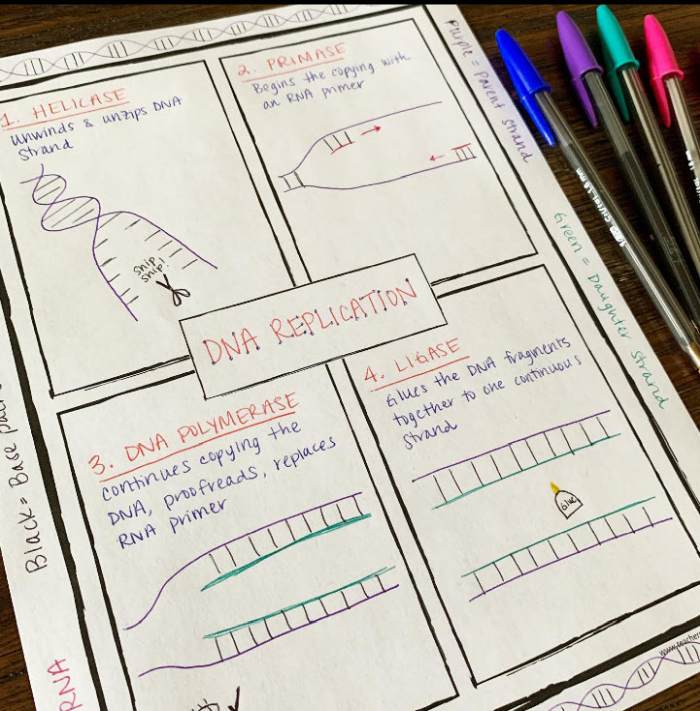
Simple DNA One-Pager
We like this one-pager example because it shows students that you don’t need to be an expert artist to create something meaningful.
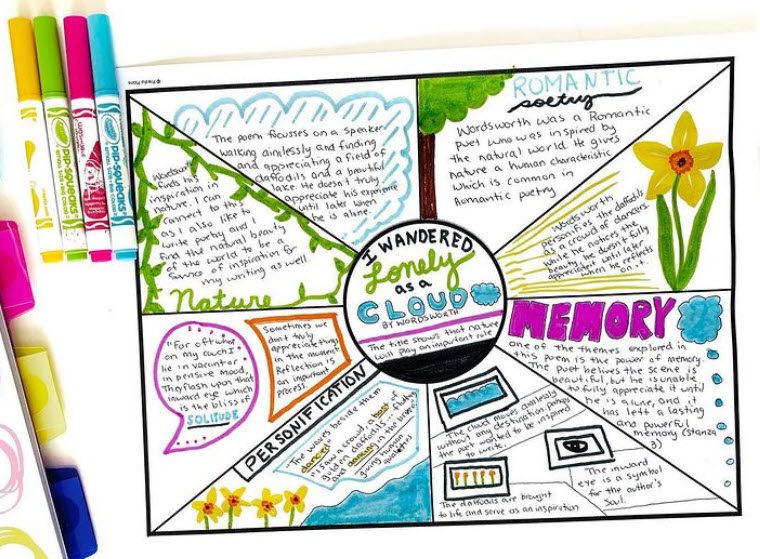
Poetry One-Pager
Here’s an example of how a template can provide students with strong guidance to get them started. This one-pager has more words than illustrations, but it’s still colorful and engaging.
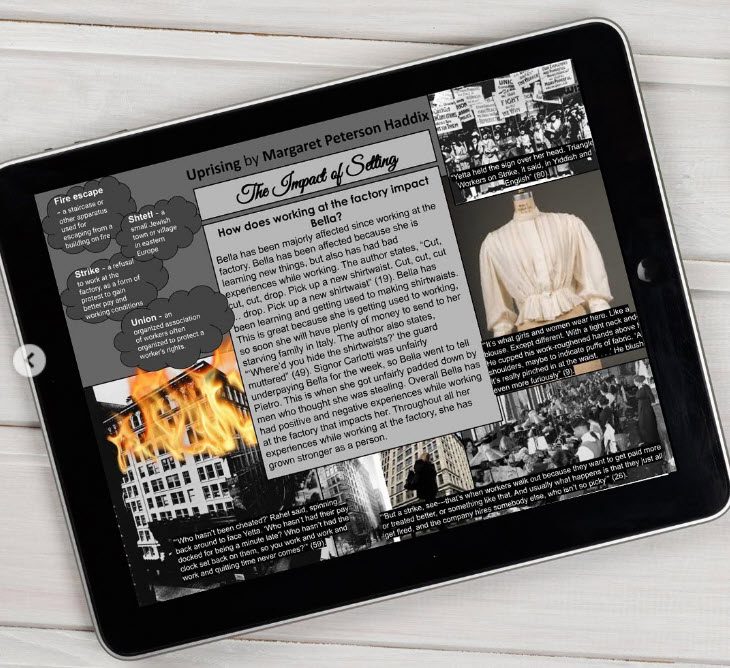
Digital One-Pager
One-pagers can go digital too! Try a whiteboard tool like Jamboard to make the process easy.
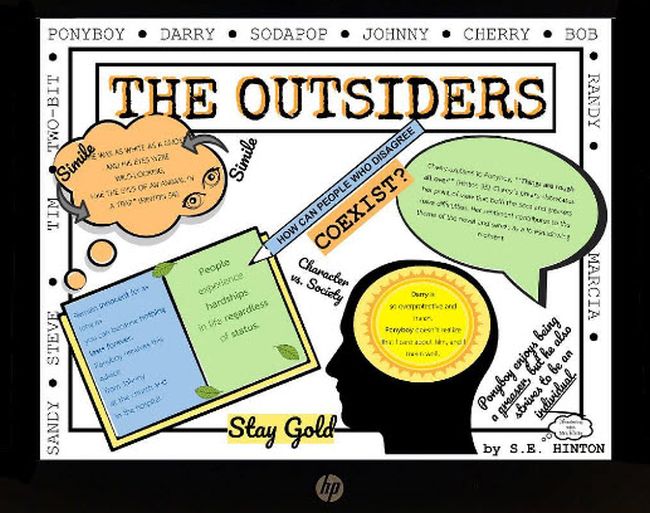
The Outsiders One-Pagers
Take a look at these two different one-pager examples, one handwritten and one digital—and both effective
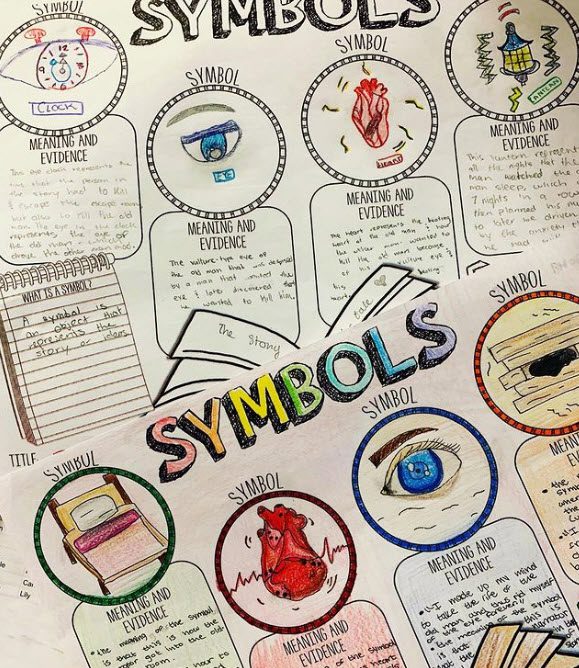
Symbols One-Pager
Here’s another terrific way to use a template. Students can sketch the symbol, then add in handwritten notes for more info.
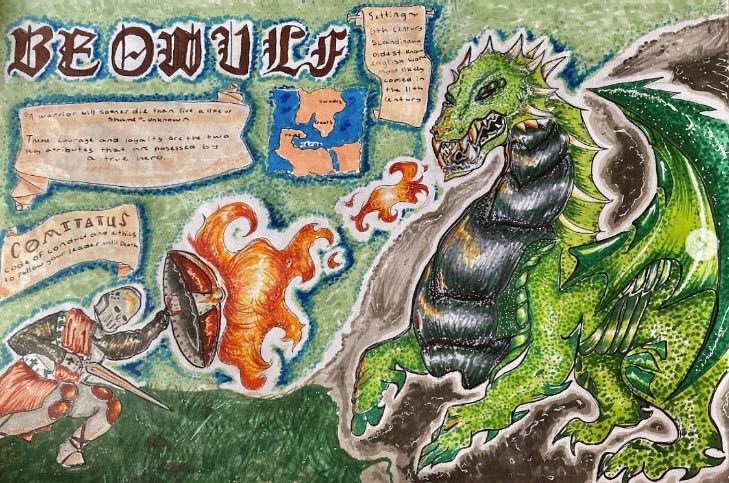
Beowulf One-Pager
This note-taking option really gives artistic students a chance to shine! Just make sure they add enough information (graphic or text) to help them make connections with what they’ve read.
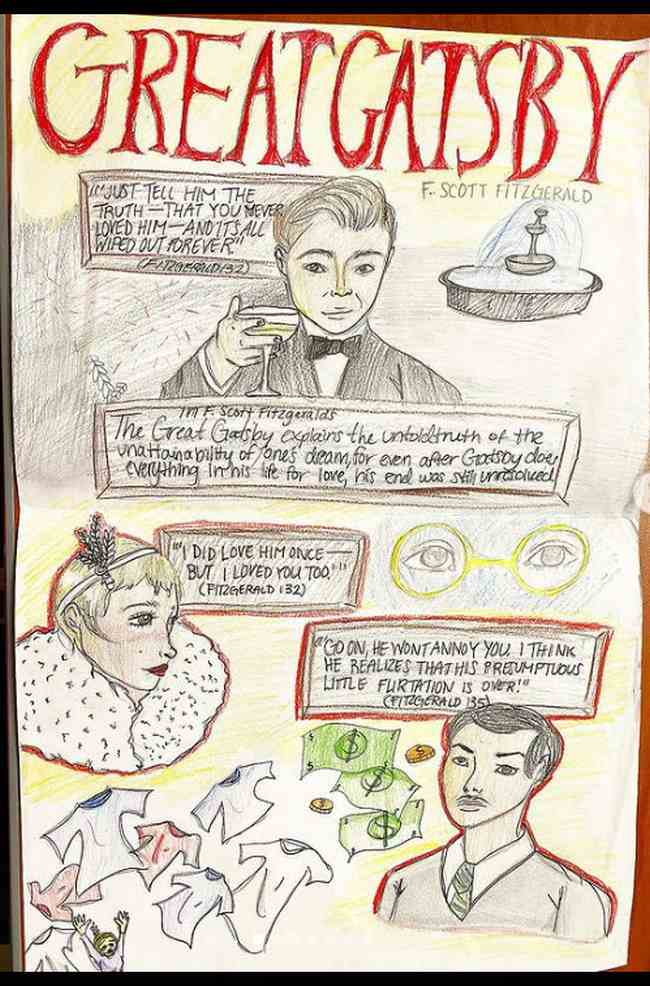
The Great Gatsby One-Pager
Sketching characters from books can bring them to life for readers. Highlight a few quotes that truly express their personalities.
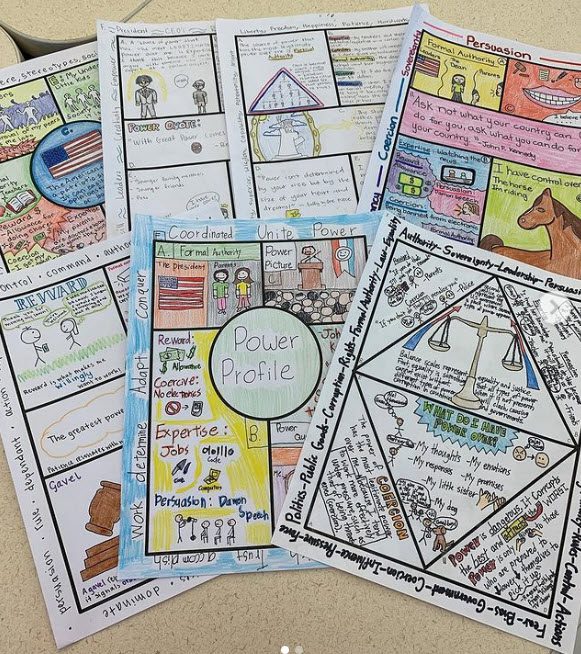
Power Profiles One-Pager
Students can use one-pagers to demonstrate what they know. They make interesting alternatives to essays or book reports.
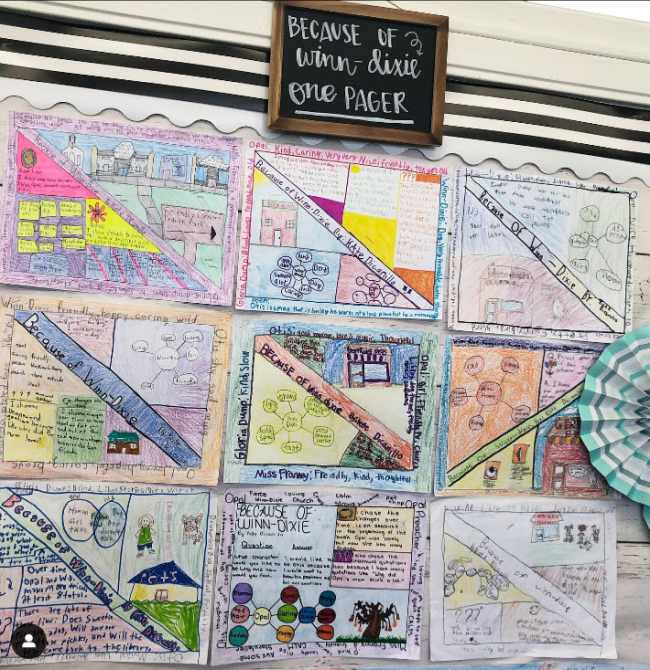
Because of Winn-Dixie One-Pagers
Note that although each student used the same basic template (hand-drawn too, so don’t worry about making copies!), they each created something different and meaningful to themselves.
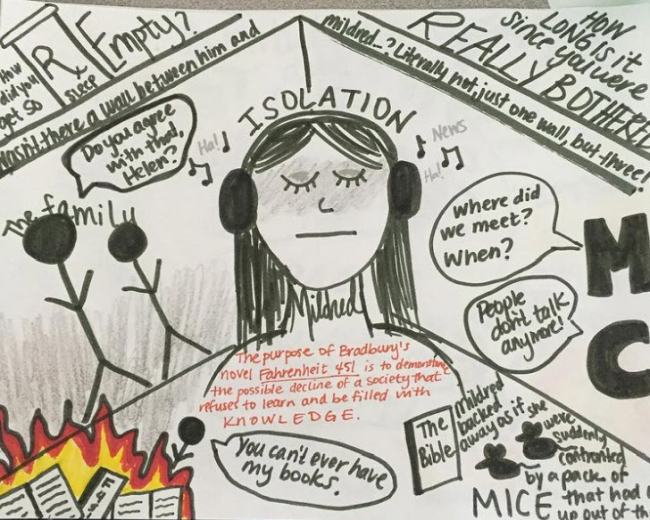
Fahrenheit 451 One-Pager
Encourage students to add at least some images to their Sketchnotes, even if they’re as simple as stick figures or outlines. This engages different parts of the brain than just writing words does, and it deepens recall.
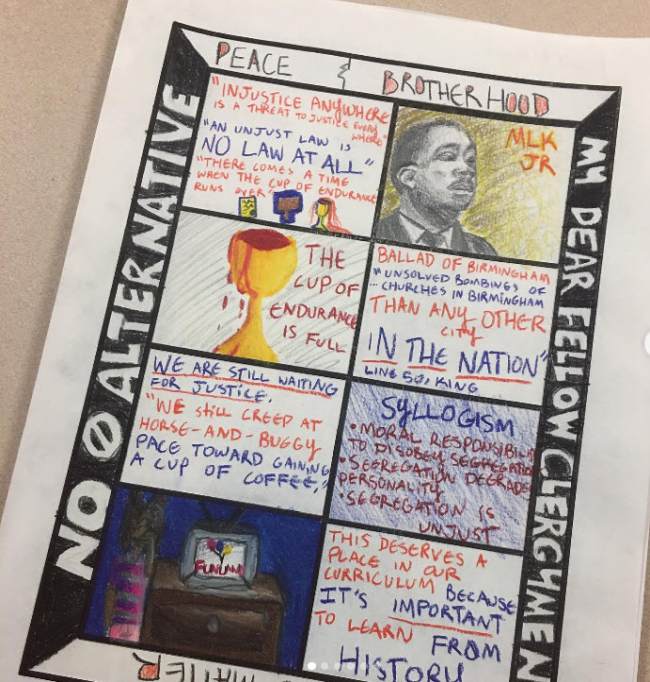
Letter From Birmingham Jail One-Pager
Even when writing text, try to use a variety of colors and styles for emphasis. Just shading a background can draw the eye to something important.

Geography One-Pager
One-pagers are terrific for comparing and contrasting information, like this one comparing how geography affects the lives of people in China and India.
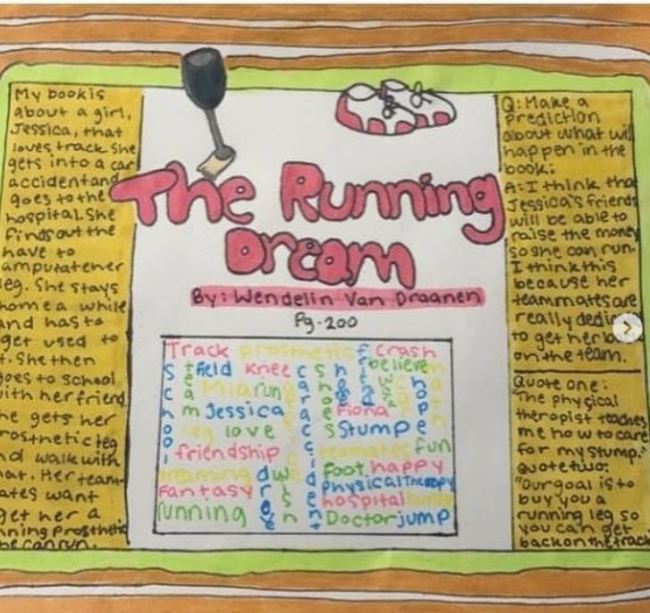
The Running Dream One-Pager
We love the idea of adding a word cloud to a one-pager! If you’re making a digital version, try these word cloud generators .
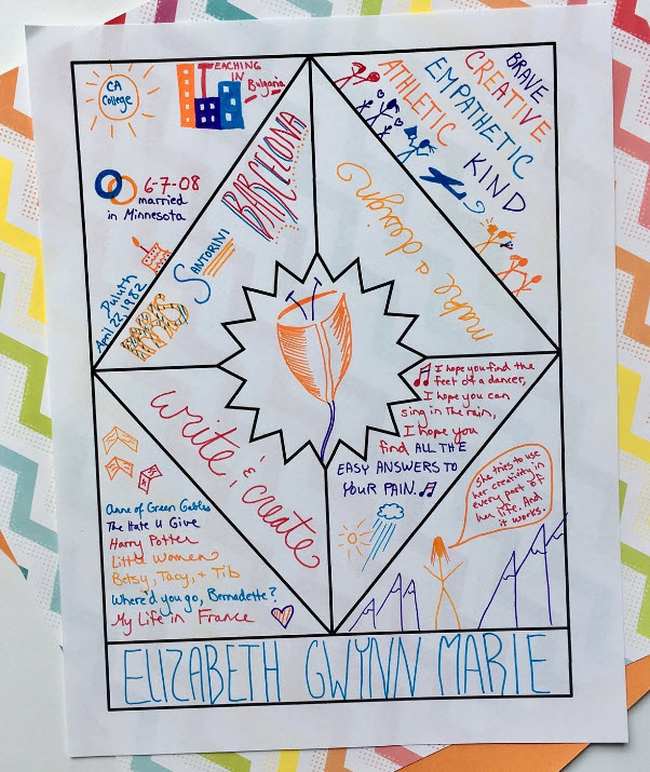
Intro One-Pager
One-pagers are such a fun way to do a getting-to-know-you activity on the first day of class.
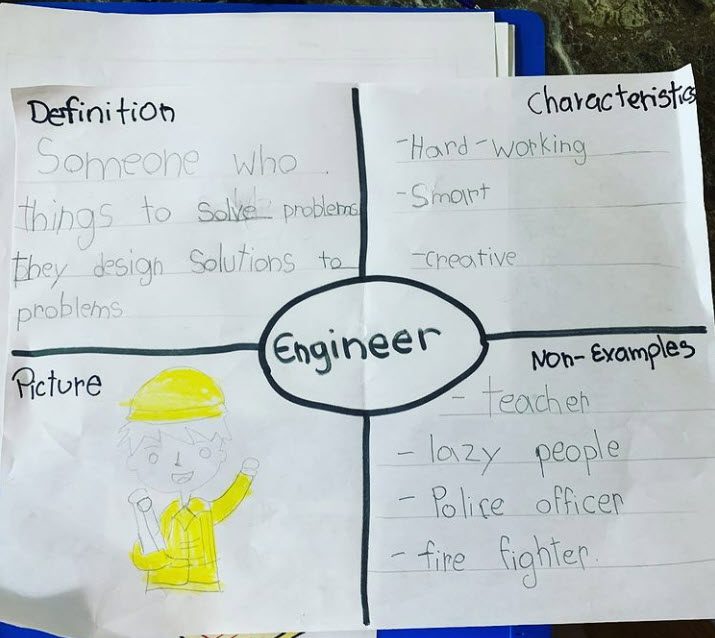
Frayer Model Vocab One-Pager
The Frayer model graphic organizer is a terrific lead-in to more creative one-pagers, and a nice way to get students more comfortable with the format.
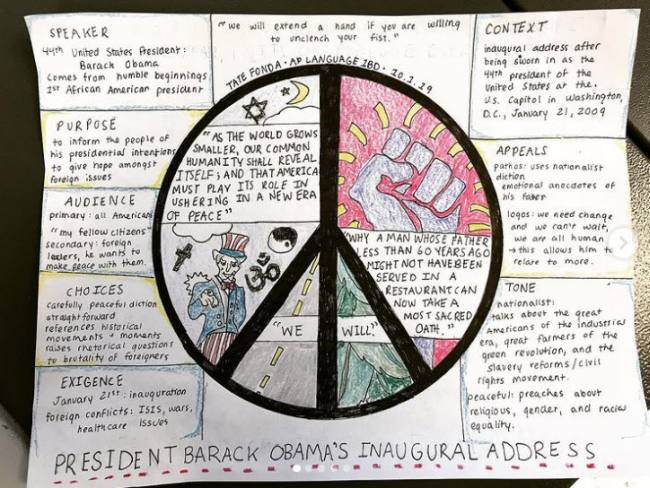
Inaugural Address One-Pager
The main image choice can set the tone for an entire one-pager analysis.
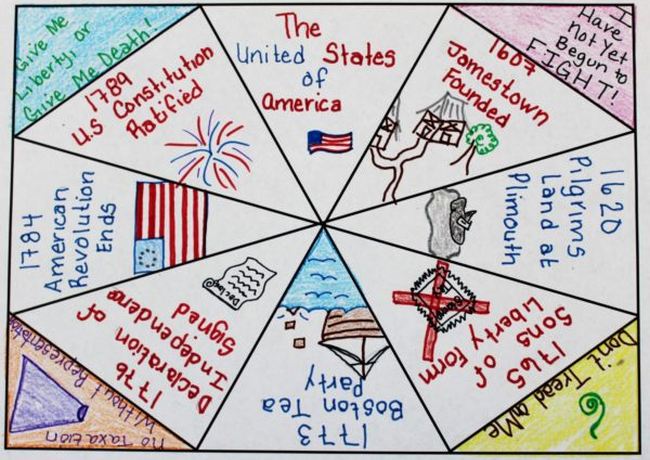
USA One-Pager
Don’t be afraid to try one-pagers in any class, for any topic!
Want to share more one-pager examples or ask for advice? Join the conversation in the WeAreTeachers HELPLINE group on Facebook .
Plus, get our free reading comprehension strategies bundle ..
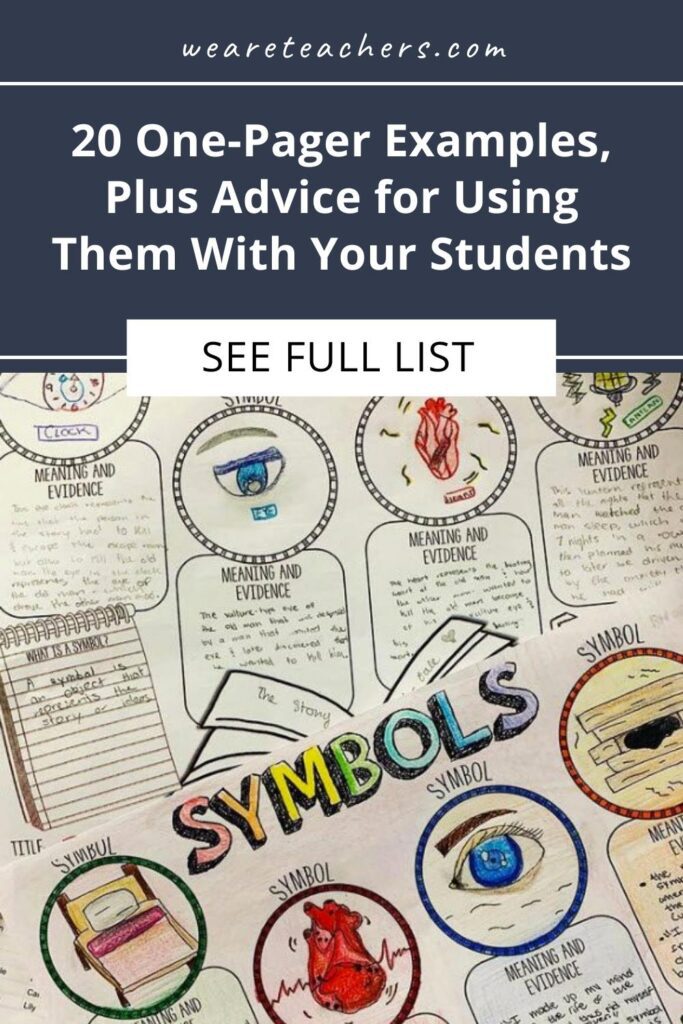
You Might Also Like
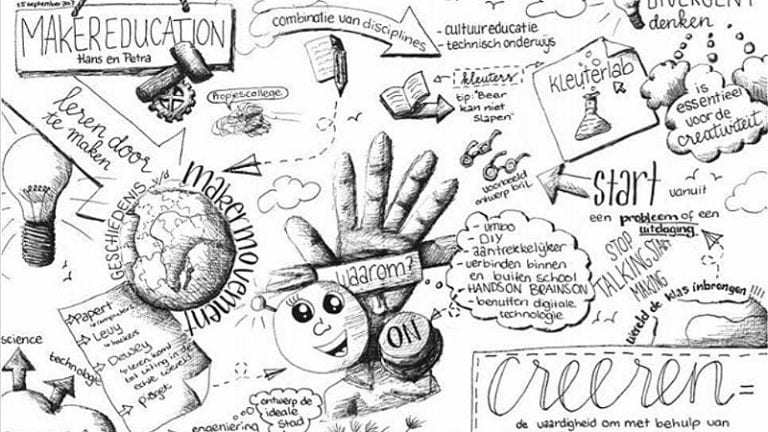
8 Creative Ways to Use Sketchnotes in Your Classroom
It's like doodling with purpose. Continue Reading
Copyright © 2024. All rights reserved. 5335 Gate Parkway, Jacksonville, FL 32256
A Simple Trick for Success with One-Pagers
May 26, 2019
Can't find what you are looking for? Contact Us
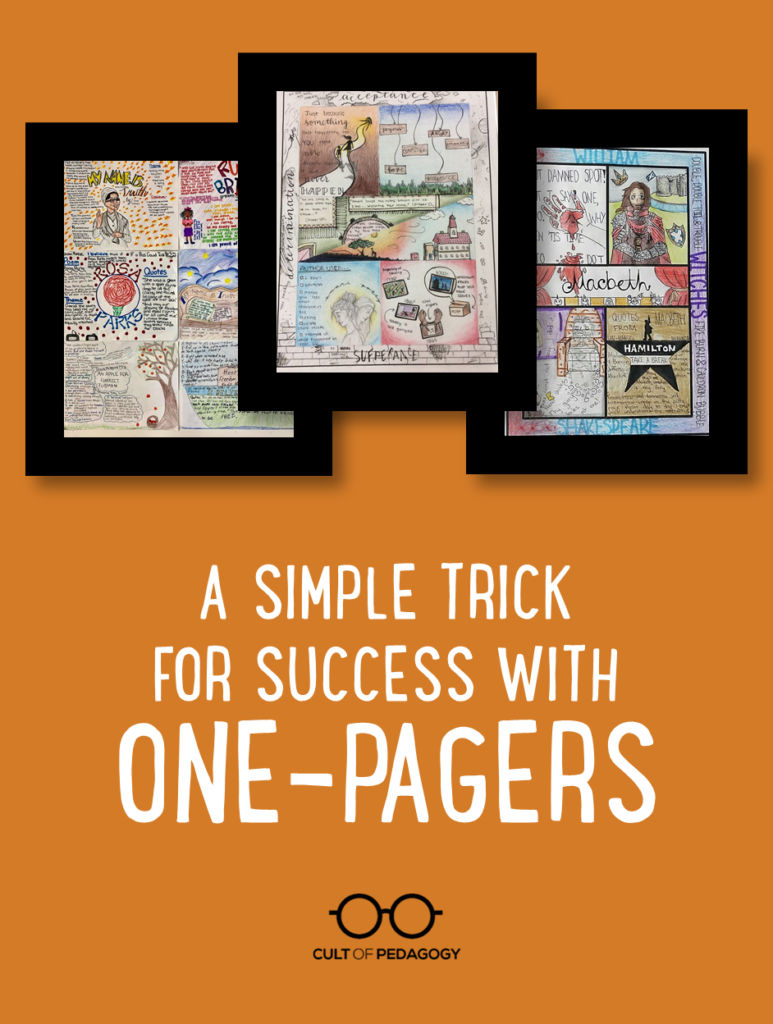
Listen to my interview with Betsy Potash ( transcript ):
Sponsored by Chill Expeditions and Kiddom
Have you heard the whispers about one-pagers in the online teacher hallways? The concept of a one-pager, in which students share their most important takeaways on a single piece of blank paper, has really taken off recently.
The one-pagers I see on Instagram draw me in like a slice of double chocolate mousse cake. The artistry students bring to representing their texts on a single piece of paper, blending images and ideas in creative color, is almost hypnotizing for me. Perhaps you’ve had the same experience.

But it’s the very beauty of the models that get posted that can drive students and teachers away from the one-pager activity. Sure, it’s great for super artistic students , we tend to think, but what about everyone else?
Turns out it CAN be great for everyone. As long as you know how to structure it.
What Is a One-Pager?
Let’s backtrack a bit and talk more about what a one-pager is. It’s pretty simple, really. Students take what they’ve learned—from a history textbook, a novel, a poem, a podcast, a Ted Talk, a guest speaker, a film—and put the highlights onto a single piece of paper. AVID first developed this strategy, but now it’s widely used in and out of AVID classrooms.
But why is this seemingly simple assignment so powerful?
As students create one-pagers, the information they put down becomes more memorable to them as they mix images and information. According to Allan Paivio’s dual coding theory, the brain has two ways of processing: the visual and the verbal. The combination of the two leads to the most powerful results. Students will remember more when they’ve mixed language and imagery.
Plus, one-pagers provide variety, a way for them to share what they’ve learned that goes beyond the usual written options. Students tend to surprise themselves with what they come up with, and their work makes for powerful displays of learning. Plus, they’re fun to make. Let’s not pretend that doesn’t matter.
So, assuming you’re sold on trying this out, you’re probably wondering what exactly goes into a one-pager?
Students might include quotations, ideas, images, analysis, key names and dates, and more. They might use their one-pagers to make connections to their own lives, to art or films, to pop culture, to what they’re learning in their other classes. They might even do it all. You’d be amazed at how much can fit on a single piece of paper.
Many teachers create lists of what students should put inside their one-pagers. Knowing they need two quotations, several symbolic images, one key theme, etc., helps guide students in their work.
The Art Problem
When creating one-pagers, artistic students tend to feature more sketches, doodles, icons and lettering. Students wary of art tend to feature more text, and can be reluctant to engage with the visual part of the assignment at all.
It was this issue—the issue of the art-haters—that first drew me into one-pagers two years ago. I had seen some stunning one-pagers posted in my Facebook group, Creative High School English . But the comments that followed were always the same. “That’s amazing work! But so many of my students don’t like art….”
Those comments struck a chord with me. For years I had dealt with comments from some of my own students about their distaste for artistic materials when I would introduce creative projects. No matter how much I explained that it was the intention behind their choices that mattered, I always got some pushback if there were any artistic elements involved in a project.
Was there a way to tweak the one-pager assignment so every student would feel confident in their success?
Another problem was one of overall design: Though they knew they needed to hit all the requirements their teachers listed, students still seemed to be overwhelmed by that huge blank page. What should go where? Did colored pencils really have to be involved?
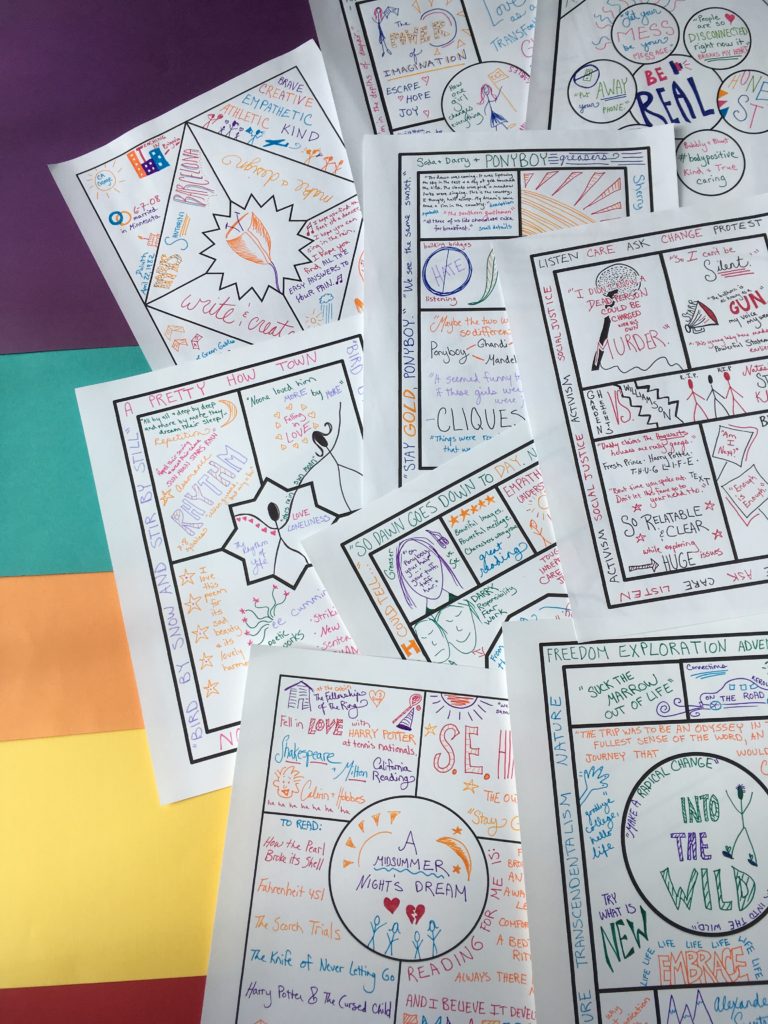
A Simple Solution: Templates
As I thought about the problem, I wondered if students would feel less overwhelmed if they knew what needed to go where. If the quotations had to be in the middle, the themes in the upper left, the images across the bottom, etc. I began to play around with the shapes tool in PowerPoint, creating different one-pager templates.
Then I began shaping my requirements, correlating each element with a space on the paper. Maybe the border could be the key quotations. The center would feature an important symbol. The themes could go in circles around the center. I developed a bunch of different templates for varied ways to respond to novels. Then I tried podcasts. Films. Poetry.
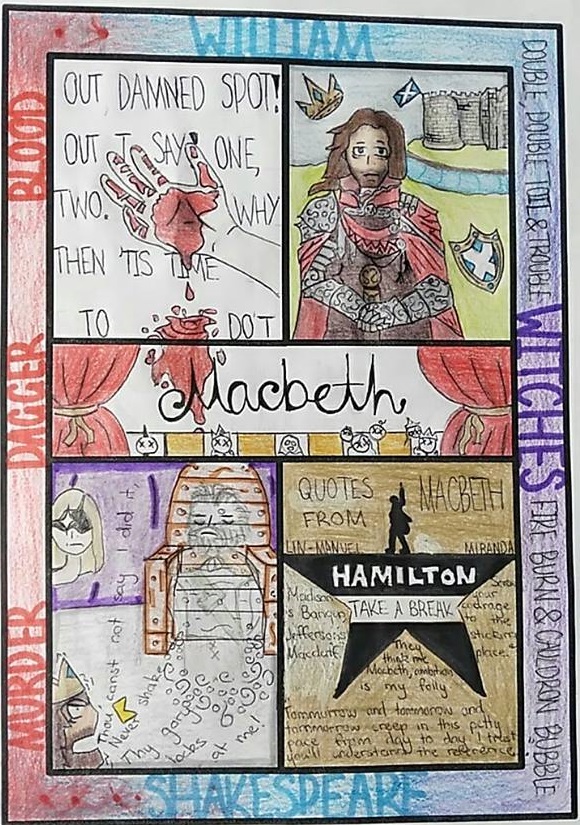
As I shared these templates with other teachers, I kept getting the same feedback: “It’s working!”
That little bit of creative constraint actually frees students to use their imagination to represent what they have learned on the page without fear. They know what they need to put down, and where, but they are also free to expand and add to the template. To choose their own colors. To bring out what is most important to them through their creativity and artistry. And those super artistic students? They can just flip the template over and use the blank page on the back.
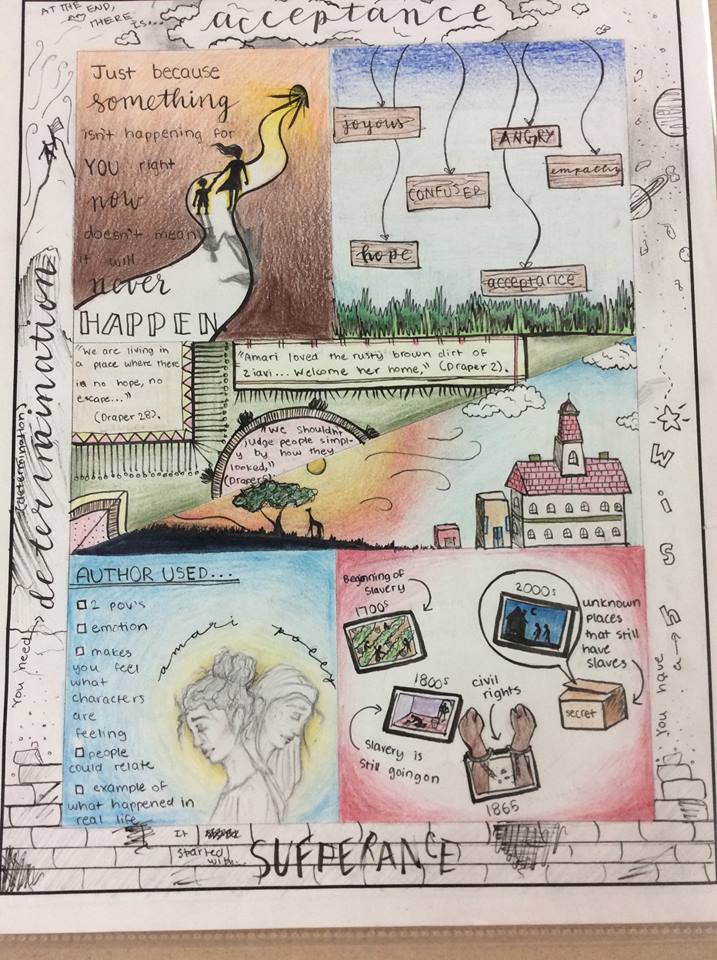
Beyond Novels
There are so many ways to integrate this creative strategy into your classroom. While one-pagers lend themselves beautifully to final assessments after reading independent novels, literature circle selections, or whole class novels, that’s really just the beginning.
You can use them to get to know students better, as with a name tent or “about me” one-pager at the beginning of the year. One school used templates to have every student create a one-pager about their own lives, collecting them all into hallway displays as part of a project they called “Tell your Story.”
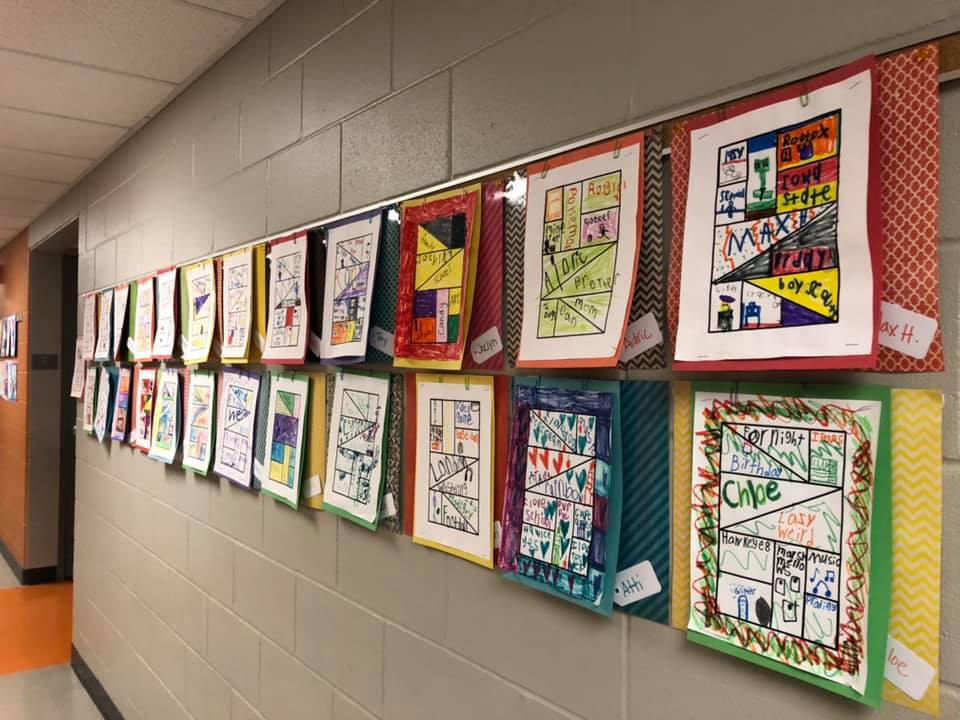
You can also use them to help students focus in on the most important information in nonfiction articles and books. One EFL teacher in Croatia used the templates to have students share key takeaways from articles they read about social media. Not only did students have to analyze the text deeply to figure out what was most important, but the dual-coding theory suggests the process of creating the one-pagers will help them remember the information better.
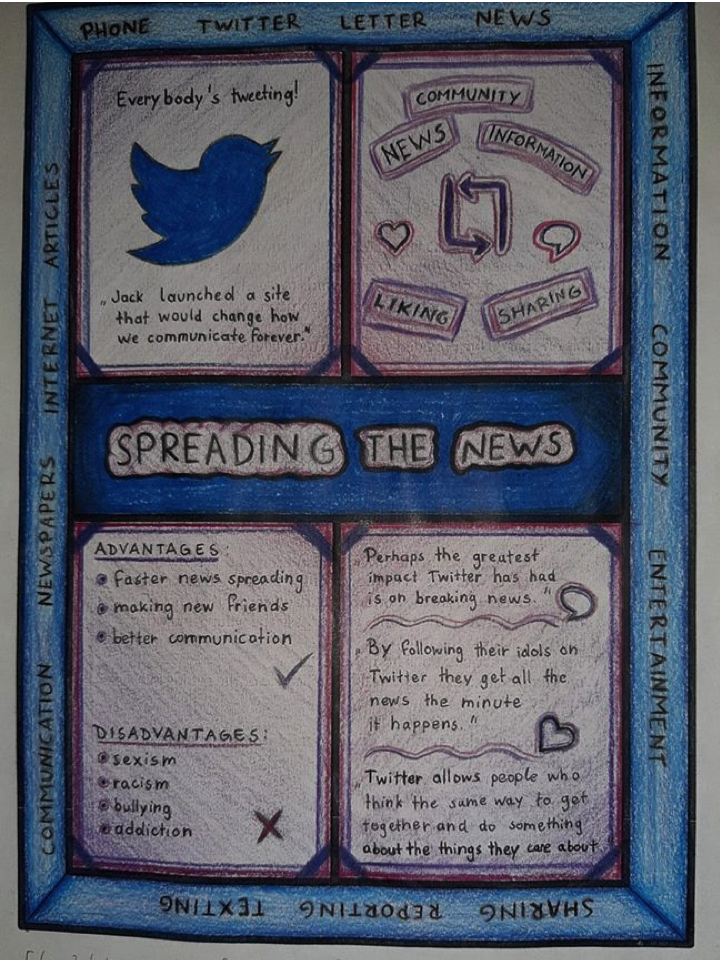
Another great use for one-pagers is to keep students focused while absorbing media. When students are watching a film, listening to a podcast, or even attending an assembly with a guest speaker, they can be creating one-pagers as they listen, a kind of formalized version of sketchnotes.

Simple Steps for One-Pager Success
Whenever you’re considering your options for assessment, throw one-pagers into the mix. The steps below should help you in creating an assignment for which every student has a roadmap to success.
1. Choose the elements you want your students to put onto their one-pagers. For example, quotations, key themes, literary elements, discussion of style, important characters or dates, connections to other disciplines, connections to their lives, connections to modern culture.
2. Create a layout using the shapes tool in PowerPoint or something similar (or grab a free set of templates here or here ).
3. Connect your instructions to your layout. Make it clear which elements should go in which area of your template.
4. Create a simple rubric with the key categories you want your students to succeed with. With literary one-pagers, I use “Textual Analysis,” “Required Elements,” and “Thoroughness.”
5. As you introduce the assignment, show students some examples of one-pagers to give them a sense for how they might proceed.
6. Give students time to work on their one-pagers in class so they can ask you questions. Consider providing some artistic materials if you can, or inviting students to bring them in. You can always let them complete the work at home if necessary.
7. Do a gallery walk of the one-pagers before you collect them, or have them present to each other in small groups. The students will learn a lot from seeing each other’s representations.
8. Create a display after you grade the one-pagers with your rubric.
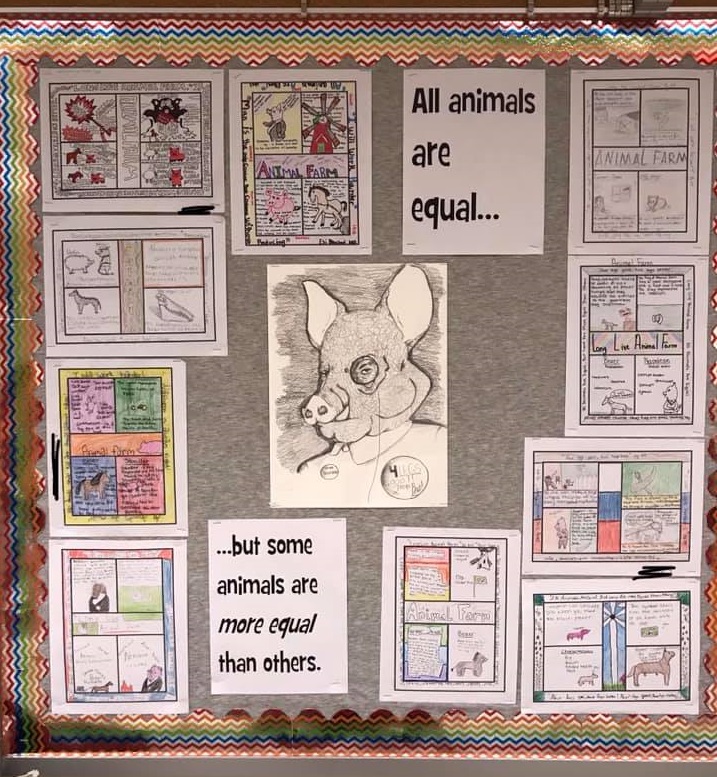
You can find more of Betsy’s great ideas on her website, Spark Creativity .
Come back for more. Join our mailing list and get weekly tips, tools, and inspiration that will make your teaching more effective and fun. You’ll get access to our members-only library of free downloads, including 20 Ways to Cut Your Grading Time in Half , the e-booklet that has helped thousands of teachers save time on grading. Over 50,000 teachers have already joined—come on in.
What to Read Next

Categories: Instruction , Podcast
Tags: assessment , English language arts , teaching strategies
61 Comments
Using this for assessment is also a great idea to provide an idea of student learning. Can you comment on how you use these for assessment and how you assess the one-pagers? Thanks!
Hi Kim, I think one-pagers make a great closing assessment for many units. They provide a chance for kids to really sum up everything they’ve learned, whether it’s from a novel, a series of poems, a part of history, etc. I think it helps a lot to grade them from a clear rubric – if you download my free set of templates, it includes the rubric I designed. You might want to grab it, just to help you design your own if you prefer. Hope this helps! Betsy
i think the students really help between to encourage other students to be creative and loyal to others and make up your own ideas.
Can you share a link to your rubric templates?
Hi Tish, you can go to A Simple Trick for Success with One-Pagers and find the links to the rubrics. If you look at the captions under the images, there’s a link to download them directly. Hope this helps!
I assess one-pagers against our education department’s rubric for written work – we have one for personal response (ideas + presentation) and another, more elaborate one for essays (content + support + form/structure + choices + correctness). It transfers nicely to one-pagers, and provides enough buffer for the kids who fear the artistic components. Here are our rubrics: https://www.alberta.ca/assets/documents/edc-2019-2020-ela30-1-scoring-guide.pdf
Hi there! This is awesome! Do you have any samples or formats for a math class? Algebra 1 and Geometry? I can see this more so with geometry since there’s lots of shapes and visuals. Thanks for your help and input!
I had students make a math one (I teach 6th grade) as a 2nd semester review. They had to include 3 things from each unit from that semester. Since we had 5 units, they broke the paper up into 5 sections.
Hi Brittany, That sounds like a wonderful review! Did you encourage them to bring in some visuals and color to help bring the concepts to life? I hope it went well! Betsy
Hi Janice, I’m afraid I don’t have any examples for math, but I think it would work very similarly. I would suggest template sections on main ideas from the unit, illustrations of the main ideas, connections to students’ own lives and the modern world, connections to other math concepts, etc. I hope that’s helpful! Betsy
I love this idea! I’m wondering how to tweak it to use in our math classrooms. Time to start experimenting. Thank you for this!
This is so helpful. I am a math teacher and a mother. My teenage son would come to a screeching halt whenever he had to generate a visual representation, because he dd not know how. I finally convinced him that, since the teacher had not *taught* him any art, and would not be *assessing* him on the artistic merit of his work, that, for instance, tracing was an ok thing to do. We expect kids to “do art” when they have not been taught how to, and some of them are not in a position (for whatever reason) to spontaneously “do art.” Why is this? (BTW, I hold a BFA.)
Hi Johanna, I hear you! It’s sad for me how little artistic outlet our students get these days, if they don’t choose to follow it on their own. It’s one reason I love this type of assignment, that can let those who flourish with art fly, and provide some reasonable small steps for those who feel intimidated by it. I’m glad you found these ideas helpful! Betsy
I’ve been hearing about these for a while! So glad to see this break down of the activity. I think creating templates is such a wonderful idea to help those students who struggle to see themselves as creative. I had my writing students create infographics this past semester, and showing them all the templates on canva really helped them feel more comfortable with creating their own examples of the genre. I’m definitely going to give this activity a try, potentially as a shareable attachment to their short autobiographies at the beginning of the semester. Thanks for the idea!
Erika, I’m so glad you find the template idea helpful! I couldn’t agree with you more about how helpful it is to share some structure ideas when approaching a design task – I love Canva too. I’ve seen some great results with one-pagers reflecting kids’ own lives, so I hope the autobiographical one-pagers will turn out well for you!
Another way to get around the “art” issue, is to use digital templates online such as the pre-set templates available on platforms like Pictochart, or create your own to share and use within Google Classroom. Encourage students to use free graphics from Copyright Commons approved sites, create comic strips to import from tools such as Pixton, etc. Another way to increase student engagement and engage in multimodal meaning making…
What great ideas! I love giving kids the option to go digital if they feel comfortable in that design space, and these are a lot of wonderful specific options. Thanks!
I teach high school physics. I can think of ways for astronomy and earth science but what of Newton’s laws or projectile motion. A section for equations. A definition perhaps. What else? Any suggestions?
What about sections that illustrate some of the principals, and a section that shows examples of practical applications of the scientific laws in students’ own lives?
I’m a science teacher, too. I know someone who assigned “Newtoons”, where kids had to think of a real world example and apply Newton’s laws to it in the form of a cartoon. Perhaps that could be incorporated into a one pager?
I think I will check out Newtoons
I would love some advice on how to use this with college math students.
Hi Lauren, I think it can be adapted to math with pretty similar template sections. You could have sections for main concepts, key equations, connections to other math or science concepts, connections to the real world, etc. And throughout, you could encourage students to create visuals that demonstrate the information to go with their text. I hope that’s helpful! Betsy
I went digital with one pagers this spring. Students used Adobe Spark to create and published on a class Padlet. Voila! No art supplies needed (and by May, few are to be had!).
Digital is a great option for one-pagers! Canva would be another fun place to experiment for those without access to Spark.
One other alternative is to pair up two students for the one-pager. One student could be more artistic/visual and the other more textual. Such a pair would have to learn to cooperate, communicate, and build on each other’s strengths. The process could be just as important as the product. Alternatively, each person in the pair could separately come up with various parts of the design. They would then meet to choose which elements to include or re-design to make the one-pager.
Tim, This is a great idea! Thanks for sharing.
Hi, I love having students gallery Walk their one pagers, but not sure what sort of accountability piece to have students complete as they do the gallery Walk and examine each other’s works. Any suggestions would be great!
Hi Courtney, I may have some suggestions for you for this. When my students do gallery walks, they usually complete a graphic organizer that sits with the work of each author. There are two forms I like to use: the Glows and Grows and the TAG sheet. The format is up to you but it can be as simple as a 2- or 3-column table on a page. The Glows and Grows is just two categories: One glow telling what the author did well, and one grow telling what they can do to make their work even better. The TAG sheet is similar but takes it one step further. T- Tell something you liked, A- Ask a question, G- Give a suggestion. I find that both these tools help students recognize good practices in their work of their peers, help them to spot errors that they might want to avoid, and give solid feedback that they respect because it’s coming from their peers. Hope you find this helpful!
What a cool way to let each student play to their own strengths. Thanks for sharing!
Thanks for this simple break down. I do a lot of writing and I’d like my students to be more reflective of what they learn from each assignment, particularly when we address a new style of writing. Any suggestions on how to use this with writing?
Hi Lauren, There are a few solid ways to use one-pagers around writing. One is to use it as an argument writing activity, or pre-writing. You can create a template where there are places for main ideas, counterarguments, quotations, and a thesis, all to be shared through both text and imagery. Another option would be to get meta and create a one-pager that is actually about the type of writing the student has just tried out and reflects the work they did and what they need to improve. With this type of template, you could create space for the main structures of the writing, what the student excelled at, and what they need to work on for the next iteration. Again, all to be shared through both text and imagery. Yet one more option would be to create a series of mini-one-pagers throughout the year that reflect writing type. So you could teach them the structures of different types of writing and have them create small illustrated versions to put together as a guide for themselves moving forwards. At the end of the year, they’d have a little book illustrating argument writing, opinion writing, compare and contrast, etc. Hope those ideas help! Betsy
I love one pagers and have used them for the last few years both with and without the template. I also taught my students how to make an infographic this year using Canva and they loved it. I think next year, I will combine the two and have them make their one-pager electronically so that both the artistic kids and the non-art lovers can be equally successful.
I have been doing projects similar to these for many years:))) Love the way you broke the ideas into steps and defined the process. Templates are great!!!!
I provide the option of collaging from magazines for my students who see themselves as less artistically inclined. They can do just collage or combine collage elements with some of their own drawings. I find this makes them feel less insecure about their drawing abilities. An unintended bonus is that some students have realized that they can be artistic without having to put pencil or paint to paper.
Love this idea of a collage for an option! I am trying one pagers this year in history to review units prior to quizzes and tests.
Love these. I have often used the Frayer model – with adaptions- for math and science concepts and or just terminology.
I used One-Pagers with my AP Human students as an end of year review. Students had to do one One-Pager per chapter. My students told me this was the best review and the most enjoyable work they did all year. They really felt this prepared them for the AP exam. Even the non-artistic students did a beautiful job!
I am using this as a project for a movie we’re watching. I’m allowing them to utilize the template or free-style, as I have quite the range of skill and anxiety in my class. Thank you for sharing.
Vickie, We are glad to hear that you’re planning to use one-pagers in your class. Let us know how it goes with your students.
How do you encourage students to use images? In providing a checklist of items I wanted students to include, somehow the One-Pagers my students recently completed for social studies included mostly text. Do I also require a certain number of images? amount of color? When I used One-Pagers last year, they were much more successful. I don’t recall how my prompt was different. I use your marvelous templates (thank you) and examples (thank you again) and the directions that identifying specific information needs to be considered. What is missing? Why aren’t the images a focus? How might I change my prompt.
With appreciation, Lisa
Hello! What is the research behind one-pagers? I would like to incorporate this method into my classroom.
This is wonderful, and it’s exactly what my students need! I’ve wanted to incorporate one-pagers into our units, but my anti-art, special ed students have balked at the idea. Thanks for sharing these templates!
Stacy, We are glad that this is exactly what you needed for your students!
I agree with all of you
I love this concept of a one pager to summarize a lesson. I teach kindergarten and can see how the students can use this technique to introduce themselves to the class.
I have never heard of the concept of using one-pagers in a classroom, though I can vaguely remember doing something very similar in a high school English class. After reading this blog post and listening to the interview, I am very excited to work this into a lesson plan that I am currently working on! Thank you for the tips and information on how to do these correctly.
I’ve tried to incorporate one pagers in my high school history classes but have struggled with how to use them effectively. The students were often intimidated or overwhelmed and the lessons seemed to flop every time. Thank you for the walk through of your process and templates. My attempts were missing the structure/parameters my students needed to be successful. I’m excited to tweak my lessons for next year and use the strategies you discussed.
Does anyone know of research related to using digital tools to write and draw and does this help or hinder learning?
Hello there. I am 14 years old. i need some help unfortunately with completing a one pager for school online. Do you know where I could go?
– Bella
Hey Isabella,
We’re sorry to hear you’re having trouble with this. Our advise is to reach out to your teacher or classmates – they should be able to help you. Good luck!
HI! Just wanted to give you a heads up that the AVID link at the beginning of the post is not working–it routed me to website that looked like a professional soccer club. I am not sure which one because the website is in Chinese, or Korean, or Japanese, or some other language I don’t know well enough to recognize! Thanks!
Hey Kelly, Thanks so much for the heads up! The link has been updated.
hey kelly , thanks so much for the heads up and thanks for everything.# love it give you the deets.
This will be my first use of a one-pager. Your information will be most valuable as I present it to the students..
This is an amazing idea! As I was reading my brain was coming up with all kinds of way I could adapt this further for Special Education when some students needs a different way to express what they’ve learned throughout a unit. I feel like so many people shy away from artistic projects so that they don’t pressure those “less artistic” students when they should be supporting their creative processes by making these projects more accessible. Wonderful read.
Hi Lauren, There are a few solid ways to use one-pagers around writing. One is to use it as an argument writing activity, or pre-writing. You can create a template where there are places for main ideas, counterarguments, quotations, and a thesis, all to be shared through both text and imagery. Another option would be to get meta and create a one-pager that is actually about the type of writing the student has just tried out and reflects the work they did and what they need to improve. With this type of template, you could create space for the main structures of the writing, what the student excelled at, and what they need to work on for the next iteration. Again, all to be shared through both text and imagery. Yet one more option would be to create a series of mini-one-pagers throughout the year that reflect writing type. So you could teach them the structures of different types of writing and have them create small illustrated versions to put together as a guide for themselves moving forwards. At the end of the year, they’d have a little book illustrating argument writing, opinion writing, compare and contrast, etc. Hope those ideas help! Betsy
woah that is soooooo cool!!!
I think one-pagers are amazing. It’s a great way to express everything and show beautiful drawings and art! All of these photos are fantastic and creative. I don’t know why, but this is my favorite way of writing and I absolutely love drawing, so this is a great way to write for me 🙂 these people skills are just.. awesome! It’s also one of the easiest ways to write. Such a great idea.
Hey the AVID link is sending me to a 404 page, also love the content of these, I am a student and I believe this helps me a lot. KEEP IT UP!
Chris, thanks for bringing this to our attention! Our team will look into it. I’m so glad the posts have been helpful for you as a student!
Leave a Reply
Your email address will not be published.

Night One Pager: Assigning a One-Pager Project as a Culminating Project

I recently assigned a one pager final project to my sophomores for their culminating Night project. I wanted to combine as many rigorous ELA content ideas as possible, while also designing a fun project for students that provided them with a bit of choice. This Night one pager project was the perfect way to finish the memoir!
To make this one pager project rigorous, I required my students to include multiple MLA-cited quotations with a literary analysis explanation. These are skills my students have learned and practiced all year long, so it was a way for me to assess that skill. I also wanted to give my students an opportunity to express their creativity, and it came through. In considering all of these elements, the one pager was the perfect culminating activity for Night!
What is a One Pager?
A one pager is a classroom assignment, activity, or assessment where students place all of their work on one page. With a one pager, students combine visual and text elements to demonstrate a thematic and symbolic meaning of a text. A one pager can include quotes from a text, quote analysis, critical thinking questions and answers, and visual representations of a setting, symbol, or character.
Furthermore, the one pager is also extremely versatile, and teachers can tailor it to fit their needs. You can read more about the one pager, sketch notes, and mind maps in this blog about coloring in the secondary ELA classroom .
Assigning a One Pager Project as a Culminating Activity for Night
For the actual assignment, I created a one-pager choice board that is similar that requires students to connect four elements. Every student had to complete the quotes, questions, and images element of the project. From there, students had their choice of four different items they could include: a connection to a song, a timeline, a setting, or a figurative language option. By providing students with a choice, they feel like they have more say with their work.
I reviewed the assignment with my students, explained my expectations, passed out the handout (which was printed double-sided with the instructions on the front and the brainstorming organizer and checklist on the back), and showed my students some examples. Keep reading the post. You can sign-up for my emails to receive a free Google Docs copy of this assignment which includes the assignment, checklist, planning sheet, and a rubric. You can receive a copy of the One Pager for FREE by visiting my Member Page !
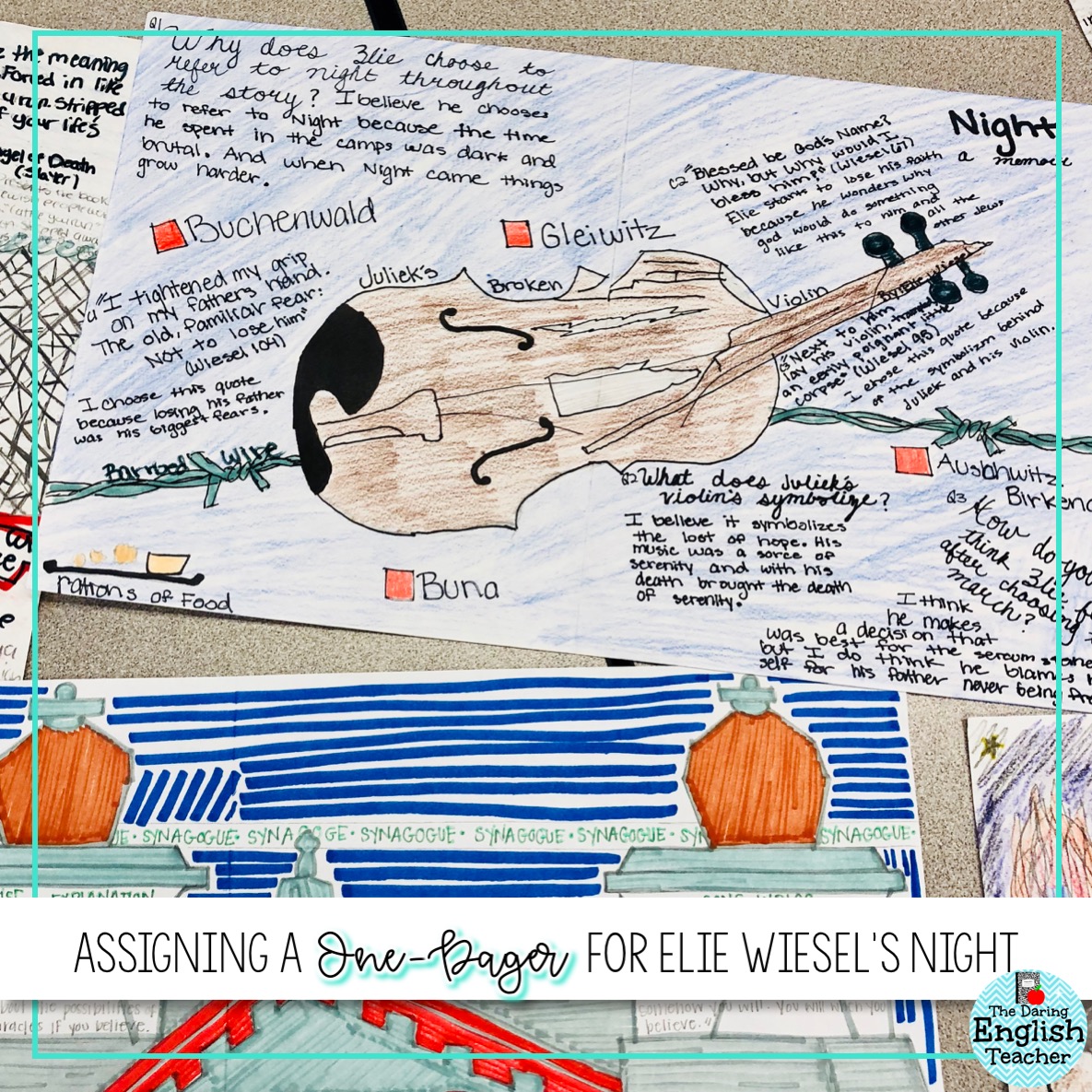
On the day projects were due, I provided my students with an opportunity to present their one-page to class. I did this as an extra-credit option. For each student who volunteered to present their project, I gave them an extra 5 points on their project).
The Night One-Pager was an enjoyable project for my students, and it was the perfect final project to assign at the end of the school year.
Teaching Night in the High School Classroom
When I teach Night to my sophomores, I use this Night Teaching Unit that includes a 5-week pacing guide.
This Night Activities Bundle includes pre-reading, during reading, and post-reading activities to use when teaching Night. This Night Teaching Unit Begin includes teaching resources and activities for you to complete with your students before, during, and after you read Night.

⭐️⭐️⭐️⭐️⭐️ Extremely Satisfied
“ This was such a great resource to add structure to my Night unit! My students found the chapter by chapter study questions to be really helpful, and I loved how easy it was to use the chapter quizzes. Would HIGHLY reccomend.”
“ When I had to teach this novel last minute and hadn’t even read the book before, this resource saved my sanity! I love resources from The Daring English Teacher, so I knew this would get me through and ensure my students were successful, even if I wasn’t 100% confident with the text.”
This post contains an affiliate link.
17 Comments
I have submitted my email in order to get the free google doc link but I have not received it yet. How long should I wait? Thank you.
It should be automatic once you confirm your email! You might need to check your spam folder.
I never received it. You?
It should be automatic. Please check your spam folder 🙂
Thanks for sharing!
I submitted my email several times to receive this, but it just redirects me to the ConverterKit website and nothing is sent to me. I have checked my spam, spelling of my email, etc. and waited 24 hours but I still have nothing. I made a ConverterKit account, too, thinking that that might have been the missing piece, but no. What am I doing wrong?
Hello! I just manually added you. You should receive an email with a passcode to access the file.
I have submitted my information repeatedy and went through the process on converterkit and still nothing. Is there something different I should be doing?
Hi. Sorry. I don’t know what the issue is. I updated the blog post with a new link though. That should help!
I requested access to this resource, and the email was never sent or received. I just wanted to make sure you were aware tha your email request link is broken still. 🙂
Hello. I just checked and it appears as if you are not signed up with the email address you inputted. If you visit the website and sign up, you’ll have access to the site.
Please send me your one pager info
Hello. I updated the post to include a new link so you can access the Night one pager!
Hello! I am having trouble accessing the link as well. It is just redirecting me to the ConverterKit website as well.
Hello. Please visit my member page or the original post to find the link.
Leave a Reply Cancel reply
Your email address will not be published. Required fields are marked *
Save my name, email, and website in this browser for the next time I comment.
Leave this field empty

SUBSCRIBE NOW
- Skip to primary navigation
- Skip to main content
- Skip to primary sidebar
Teaching Expertise
- Classroom Ideas
- Teacher’s Life
- Deals & Shopping
- Privacy Policy
38 Dynamic One-Pager Examples For Students
September 28, 2023 // by Lauren Du Plessis
Diving into an array of educational topics has never been so exciting! We’ve unearthed 38 dynamic one-pager examples that will enable your kiddos to deeply explore their chosen subjects in greater detail. By using them, students will not only deepen their understanding of various subjects but also enhance their creativity, critical thinking, and communication skills. Jump right in to discover more about how to incorporate this visual tool in your classroom!
1. Book Explorer
Calling all book lovers to encapsulate the magic of their favorite book onto a single page. Genre, characters, plots, and themes take center stage in this captivating report!
Learn More: Teachers Pay Teachers
2. Time Traveler
Buckle up for a journey through time! From Cleopatra’s Egypt to Lincoln’s America, students must etch the footsteps of history with a one-pager that pays tribute to a chosen historical figure. As they work, they should focus on highlighting the significant contributions that this person made and detailing the important events and happenings at the time.
Learn More: Note Booking Fairy
3. Little Scientists
Have your budding scientists transfer their boring textbook content onto a vibrant one pager. With flair and precision, they can craft exciting visuals and short write-ups to bring complex concepts to life.
Learn More: Teaching Muse
4. Math Maestro
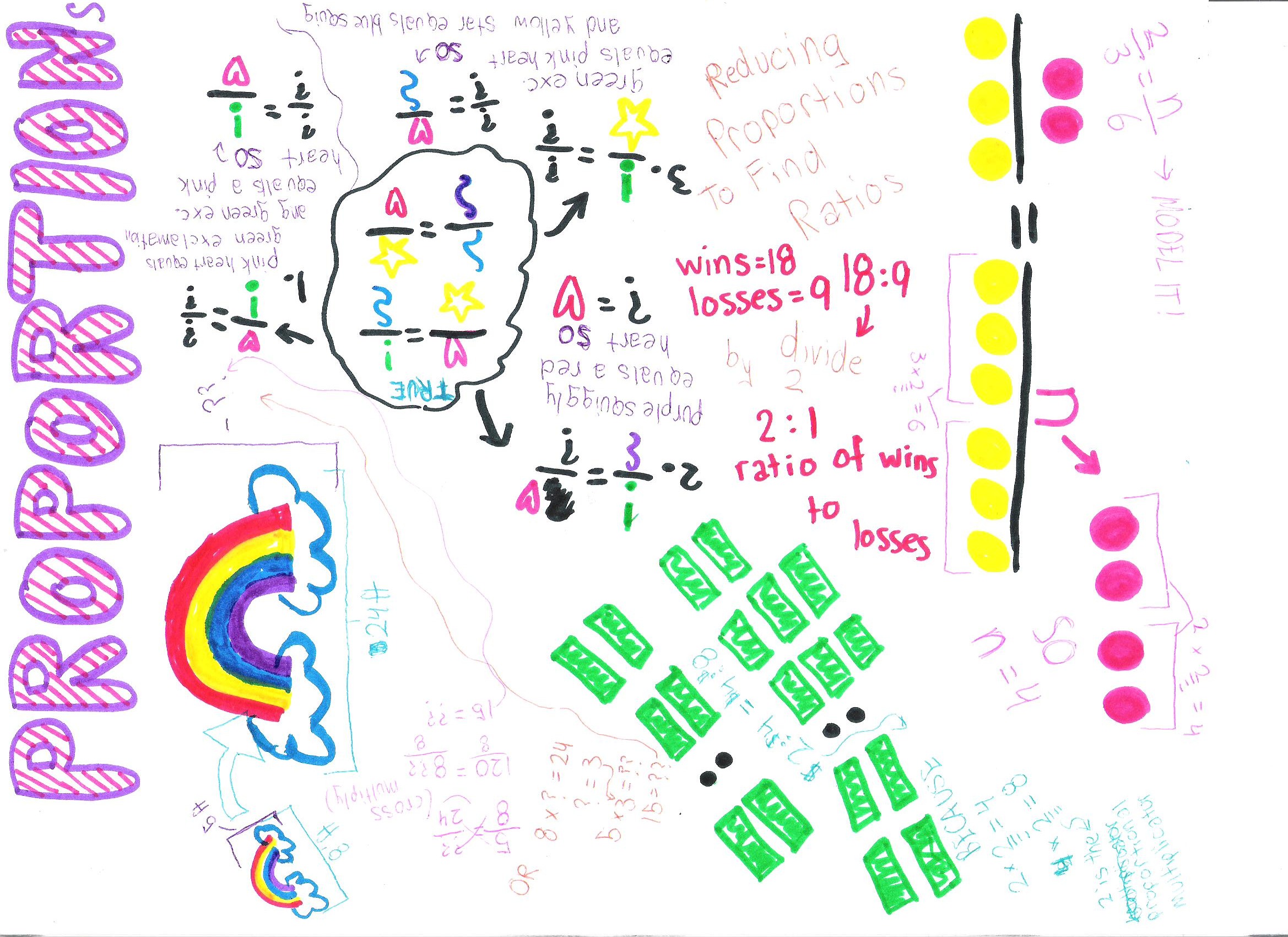
Take the mystery out of math by having your students create one-pagers that detail pie charts, bar graphs, and more; pairing them with unique illustrations and brief summaries.
Learn More: Lindsey Cain
5. Word Wizard
Have your students exhibit their command over new words; bringing them to life with definitions, synonyms, and varied sentences.
6. Geography Guru
Ever wondered about the mysteries of the Amazon rainforest or the cultural nuances of Tokyo? Have your students embark on a global expedition right from the comfort of their desks to learn more! As they conduct research on a chosen country or region, have them chronicle their journey by creating a geographic one-pager.
7. Art Aficionado
For those with an artistic flair, the art movement one pager is sure to captivate and delight! Here, students can lay out the captivating tales of trailblazing artists and the masterpieces they birthed or alternatively create a one-pager on the elements of art.
Learn More: River Trail Art
8. Field Trip Fanatic
Who doesn’t love a good field trip? This field trip one pager serves as a snapshot of these adventures; letting students share their experiences, discoveries, and insights, all while reliving the fun.
Learn More: Pinterest
9. Current Events Analyst
In our fast-paced world, staying informed matters! Encourages students to delve into the news to summarize events and discuss their implications.
Learn More: Lit In Focus
10. Career Captain
Astronaut, artist, archaeologist, or other? With this career-centric one-pager, you can prompt your pupils to take a peek into the future; exploring their dream careers and the steps they need to take in order to get there.
11. Film Critic
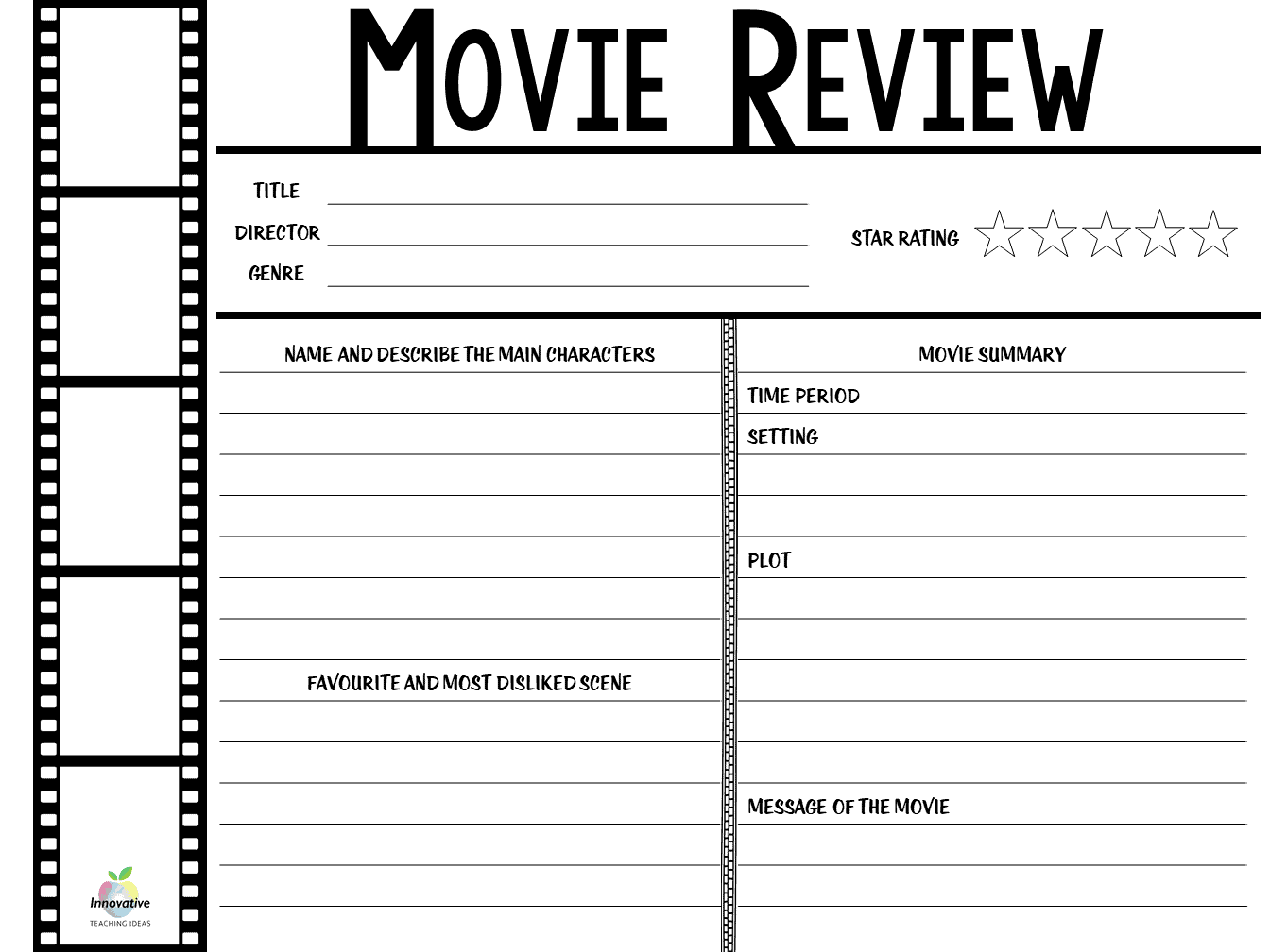
Roll out the red carpet as your students step into the shoes of film critics! Invite them to watch a film and craft a review by summarizing the story and sharing their opinion on one page.
Learn More: Visual Literacy
12. Poetry Pro
Help your kiddos unravel the threads of a poem; exploring the different types and how they are formed. Once they’re through with this one-pager, they’ll be poetry boffins!
Learn More: Types of Poetry
13. Self-Reflection Guru

Tap a moment to have your students step back and ponder their growth. This reflective one-pager lets them muse over their academic journey, personal evolution, and future aspirations.
14. Character Detective
Which book character fascinates your students the most? Have them dive into the psyche of their favorite characters by mapping their traits, arcs, and roles in this text detective one pager!
15. Animal Adventurer
Transports students into the wild by having them research fascinating creatures and their habitats. It’s a trip to a zoo that fits on a single page!
Learn More: Sparkle Box
16. Personal Hero
Young or old, we all have heroes! Give your learners an opportunity to share their admiration for their own heroes by writing about how they inspire them and make a difference in their lives.
17. Stargazer
Shoot for the stars! Invite your kiddos to become astronomers for a day; charting their understanding of various constellations.
Learn More: Teachers Mag
18. Melody Maker
Tracing musical history, key artists, and their cultural impact, your students orchestrate a symphony of information on just one page! Have them compose a one-pager on a music genre, instrument, or artist of their choice.
Learn More: Chomping At The Lit
19. Nature Navigator
Budding botanists are on the loose! Every plant tells a story and using a dynamic one-pager, your students can outline their characteristics, natural habitat, and role in the ecosystem.
Learn More: Study Lib
20. Food Chain
Map the intricacies of a food chain with a bright and bold one-pager! Learners can explore each organism’s role and the energy transfer concept, getting a glimpse at the delicate balance of our ecosystem.
Learn More: My Green World
21. Body Architect
Time for a deep dive into the human body! Ask your students to outline one of the body’s key systems and its functions on one page.
22. Community Champion
Ever considered the ripple effects of kindness? Urge your students to champion a community project and then create a one-pager to reflect on their service experience and the impact they had.
Learn More: Cathie LeBlanc
23. Eco Advocate
Invite your students to explore a sustainability topic in further detail; highlighting its importance, challenges, and potential solutions- all while inspiring us to be stewards of our planet!
Learn More: One Tree Planted
24. Starry-Eyed Astronaut
Blast off into the mesmerizing abyss of space! Guide your kiddos on an interstellar journey to uncover the secrets of a chosen planet, star, or galaxy. What mysteries do they hold? Have them dive in by creating colorful diagrams and compiling fascinating facts on a single, space-filled page.
Learn More: Kids Konnect
25. Genius Behind the Gadget
Behind every invention, there’s a tale of trials, errors, and a eureka moment. Let your little learners delve into the stories of groundbreaking discoveries! Whether it’s the brilliance of the first light bulb or the evolution of the smartphone, have your kids share these amazing stories of discovery on a vivid one-pager.
Learn More: Miniature Masterminds
26. Detective On Duty
Don your detective hat and step into a world of intrigue! Have your kiddos pick a gripping mystery and let them gather the clues as they embark on a quest for the truth. Their captivating conclusions await discovery in this thought-provoking one-pager.
Learn More: Social Studies Toolbox
27. Tech Trendsetter
In such a tech-savvy world, it’s sometimes easy to forget just how far we’ve come! Challenge your students to look more closely at an innovative piece of tech, or an app that they use, before showcasing its revolutionary features on a bright one-pager. Their one-pager will delve into the history and development of this tech and the impact that it’s had on our lives.
Learn More: Reading and Writing Haven
28. Game Day Guru
Beyond the thrill of the goals, the touchdowns, and the baskets, every sport has a story. Have the sports enthusiasts in your class dive deep into the history of their chosen sport. They can highlight legendary champions, unravel thrilling moments, and break down controversies on this fantastic page.

29. Linguistic Luminary
Language is more than words—it’s the soul of a culture. Let the linguists in your class delve into the nuances of a chosen language by presenting its intriguing origins, melodious sounds, and statistics on its use in the world today. All this information on a linguistically lush page – what’s not to love?
Learn More: Instagram
30. Weather vs. Climate
This one’s for the budding meteorologists! Let your kiddos dive into the drama of the weather sysetm, unraveling the science behind our weird and wonderful weather conditions. They’ll have fun illustrating their pages with whirling diagrams and stormy stories to create an eye-catching piece of work to explain the differences between weather and climate.
31. Short Story Spotlight
Summarize a short story with this cool one-pager idea. Have your readers take the key points from a short story and display these along with cool illustrations, personal responses, and even newly learned vocabulary all on one action-packed page!
Learn More: 9th Grade English
32. Zen Zone Creator
In our busy world, finding a peaceful corner is precious. Guide your kiddos through crafting this one-pager which focuses on mindfulness practices. You can use this idea to have them highlight and document the calming techniques that will help to keep them grounded even when they’re worked up and life feels like a lot!
Learn More: Johnston’s ELA Gems
33. Gamepad Gladiator
Welcome to the cool and exciting world of video games! Have your kiddies pick their all-time favorite game and then give them the task of creating an expansion pack, or have them create a new game entirely. They’ll love spending time elaborating on their game’s thrilling quests and challenges, whilst adding to the adrenaline-pumping moments that will keep them hooked.
Learn More: Twinkl
34. Tectonic Transformations
Shake things up with an exciting look at the Earth’s tectonic plates. Let your kiddos explore how tectonic plates move around to change the face of the Earth and what happens when they bump into each other or move apart! This fantastic idea links to both geography and science, as well as natural disaster topics.
35. Nature’s Narrator
Embrace the call of the wild! Explore love and an appreciation of nature with your class by having them each recount a memorable expedition or spotlight a survival skill that they’ve mastered, like building a fire or making a shelter. This one-pager is a super way for them to show their wild side!
Learn More: National Park Service
36. Legend Lover

Bring fantasy to life with this next one-pager idea. Let your kids explore the magical world of legends and lore, with its heroic demigods and other mythical creatures. Challenge your kiddos to recount these mythical tales by weaving their essence onto a page that’s sure to be filled with ancient allure.
Learn More: Twitter
37. Crafty Creator
DIY isn’t just a hobby; it’s a passion! Celebrate the spirit of creation with your class by having them document a DIY or craft project that they’re proud of. From the spark of an idea to the satisfaction of the final touch, encourage them to capture it all on a blank one-pager template.
38. Green Thumb Guide
Help your class celebrate Mother Nature and all she does with this home-grown project. Have your green-fingered kiddos adopt a plant, which they’ll be responsible for, and encourage them to chart its growth, take note of its needs, and observe its characteristics. Through this, they’ll cultivate not just plants, but also a deeper appreciation for nature that can be summarized in a one-page guide!
Learn More: Fantastic Fun and Learning
What is a one pager assignment? Easy tips for newbs
by mindroar | Aug 14, 2023 | blog | 0 comments
Before we get started explaining one pager ideas, let’s take answer the first question you might have, what is a one pager assignment? (Just in case you are unfamiliar or need to be convinced that they’re a great teaching and learning tool).
What is a one pager assignment?
A one pager assignment is an assignment where all of the parts of the task are completed one page.
One pager projects can take many different forms. It might be something like a comic book strip ( click here for a free template ), or it could be a cause-effect chart.
It could be a mind map. Or it could be a visual note taking worksheet that covers quotes and themes and characters.
The point of a one pager project is that the whole task can fit on one page.
Does this mean that a one pager assignment is not rigorous?
Short answer, no. A one pager project can be as rigorous as an essay or other extended piece of writing.
It might not take as long to complete as an essay or other extended piece of writing, but that doesn’t mean it’s not as rigorous.
The level of rigor on the one pager assignment will depend on how you structure the task. If you get students to do a mind map, that’s probably not going to be as rigorous as something that’s requiring students to pick out and analyze examples of characters, themes, or quotes etc.
So how you structure the one pager project will determine it’s rigor. This brings us to our second point.
Who can do a one pager assignment?
One pager projects are the type of task that many students will be able to attempt and that you will be able to easily differentiate according to ability.
That’s part of its appeal. Because it’s only one page, projects can be attempted by students with extremely high ability and students that are struggling.
One pager projects have the appeal that students know that they are only one page. That’s all they have to do, and they can add as much detail as they wish to try and achieve the grades they want.
When can you use a one pager assignment?
One of the benefits of a one pager assignment is that you can use them at all different points in your unit of work. And you can use one pager projects across many different subjects.
You can use a one pager assignment at the start of a unit to try understand students’ prior learning. You can use it in the middle to figure out where you need to go back and reteach or where students might have not understood information.
And you can use it at the end as a form of assessment.
Why would you use a one pager assignment?
First of all, you should use a one pager project because it’s a way for students to engage in the content. And it’s an achievable way for students to demonstrate their learning that is not as reliant on written communication when compared to a task such as an essay.
Students can use illustrations; they can do collage. Students can collaborate with other students, or they can work individually. As long as they can explain the choices that they’ve made, students are able to succeed.
Why else should you use a one pager assignment? Too often in English and Humanities, we get stuck on the idea that students need to be writing for in order to be assessed. But that’s not really the case.
Students must write in a one-pager assignment. That’s important because they need to be able to explain their ideas. But the advantage of a one pager project is that they can also explain their ideas visually.
Another benefit is that the writing component of a one-pager assignment is shorter and feels more achievable for students who struggle with writing. Instead of being faced with a six-hundred-word essay, students write paragraphs. And they can use illustrations, diagrams, and other visual tools to communicate their learning.
Other reasons to use one pager assignments…
Another benefit of one pager projects is that they are shorter tasks. This means that you can assign them more frequently and at different points in a unit of learning.
Because they are shorter tasks, they are faster to mark. A six-page essay will take you much longer to give meaningful feedback on than one pager.
But both tasks can potentially accomplish the same learning goal – a one pager can enable a student to analyze a quote, discuss a character’s growth, and analyze a theme. But it would take them much less time to complete than a six-page essay.
The shorter length allows you to provide more frequent feedback, and we know that more frequent feedback on how to improve is one of the ways students learn. Plus, it is a fast way for you to gather evidence of student learning.
One pagers are also a way for you to help students manage their study time. As teachers, we often forget that students have work across many subjects, and often assessment is due at the same time because of reporting timelines. One pagers enable students to demonstrate their learning in a relatively quick way.
Plus, students are likely to attempt a one pager because it seems like an easier task than a six-page essay.
With one pager projects, students are able to produce or create assessment pieces that meet the learning goals. But those assessment pieces are within students’ ability, are creative works that students are proud of, and are tasks that students have control and ownership over.
Finally, one pagers are great because they can be completed with paper or you can assign students to do them digitally on a program such as PowerPoint or Canva .
One pagers make differentiating the task easier
One pagers are a great way to cater for different learning abilities and an easy way to differentiate tasks for students of different abilities
In your classroom, you likely have students who are high achieving as well as students who struggle. In this same task, you will be able to create an assessment that caters to both groups.
You can differentiate for these different levels in a variety of ways, including
- Assigning different texts for the one pager, with higher ability students using more difficult texts
- Creating different parameters for what different students need to include on their one pagers
- Providing different levels of scaffolding for the written components of the task
- Giving students different degrees of freedom of choice of task
- Providing different levels of scaffolding for the decorative components/design of the task
- Grading students on different criteria based on the learning level they’re at (for example, if students are on individual learning plans you are able to use the grade level that they’re at to mark them)
One pager ideas for different subject areas
You might have seen a one pager assignment in English where students need to
- Analyze a quote
- Discuss how a character grows over the novel
- Analyze a theme
- Include some illustration or decorative element
But how does that translate to different subject areas or text types? What is a one pager assignment in Math and what does a one pager look like in Social Science? Some one pager ideas for different subject areas include
English and humanities
- English: Choose a scene from a text that you have read and create a one-pager about a scene from a non-narrator character point of view. This is a great way to fill gaps and silences in a text.
- History: Show the causes and/or effects of a major historical event including analysis of a primary and secondary source
- Geography: Show the causes and/or effects of a natural disaster on a group of people
- English: Compare two poems on the same theme and describe similarities and differences in structure, technique, and message.
- History: Show the changes and continuities of a specific civilization over time including analysis of primary and secondary sources
- Geography: show the evolution of a place over time and the causes and effects of those changes
- Legal studies: show the progress of a legal case from the original law, the case law that applies to it, and the outcomes of cases that changed the interpretation of the original law
- Art: discuss an artist and the evolution of their style
- Film and TV: explain the techniques a director uses to get across a specific message in a text
- English: create a blackout poem from a text and then explain what they’re trying to achieve with that blackout poem. What is the message of the poem? How does it relate to the original text? How does it create a new text?
- Science: show the hypothesis and expected outcomes of an experiment and explain which outcome occurred and possible reasons why
- Math: show what the Fibonacci sequence is and why it’s important by discussing how it appears in different locations (for example, in nature, architecture, construction, or art)
- Biology: classify different plant types and show similarities and differences between different species of the same genus
- Chemistry: classify the different chemicals in everyday products (such as shampoo) and explain how those chemicals function within the product
- Physics: show how lenses in glasses work or how pressure and gravity in household plumbing keep water flowing in the intended direction
As you can see from these one pager ideas for different subjects, there are many ways to use one pagers in many different subjects.
It’s this flexibility which also makes it a fantastic, useful teaching tool and assessment task.
How can you structure a one pager project?
So, you’re convinced. You want to assign a one pager assignment. What do you do now?
The first step is to work out where in the unit of work you want to assign it and whether it will be formative or summative.
If you want to use it as a formative assessment, a one pager idea that is useful for gauging learning is to get students to complete one at the start of the unit and one at the end of the unit. You could also do one mid-way through to see progress or areas of misunderstanding.
In this way, you are achieving a few goals. Firstly, you are gauging prior learning at the start of the unit. This allows you to work out what students know already and avoid spending too much time reviewing that information.
Secondly, this approach allows you to see student learning over time. And it gives you evidence to use in case students don’t complete summative assessment or don’t do as well as you think they should have.
Further, it is a way to avoid the dreaded AI-generated essay, because if you do it before students begin their summative assessment it can work as a forced note-taking before an extended written task.
How do you grade a one pager assignment?
Luckily, because one pager projects and one pager ideas are so flexible, grading can be quite flexible too. You’ll just need to make sure that your one pager directions enable students to complete the task and answer whichever criteria you are assessing them on.
Questions you may like to ask when designing your one pager rubric include:
- Are you going to grade the creative, decorative, or design elements? If so, how much will it be worth? This will depend on the subject area, as in some subjects such as art and design, this aspect would carry a heavier weight than a subject such as science.
- Does the design, creative, or decorative part have to be made from a specific material or media? Can it be hand drawn, or can students use collages, photos, or digital media?
- How will the one pager rubric reflect the learning area? Which learning outcomes or criteria will you assess?
- How will the task need to be designed so that students can address those criteria?
- Will students be graded on content?
- Will students be graded on written expression?
- Are spelling, punctuation, and grammar important to assess in this task?
- Are you grading paragraph structure?
- Do students need to include evidence such as quotes, data, statistics, examples, or paraphrasing?
- Which information are you looking for students to recall, synthesize, and/or evaluate?
- How will you differentiate? Will differentiation affect the grading rubric?
These questions are important because they will help you set the parameters of the task. It’s probably best to have the criteria for the one pager worked out before you design the task so that you can ensure your instructions lead students to complete the task as you intended it.
How can you assign a one pager?
An easy way to assign a one pager assignment is to give students
- A blank piece of paper (if your task will be formative, or at the start of the unit, this may be enough guidance for the task and it may be more like an illustrated ‘brain dump’ than a structured response)
- A blank comic strip template
- A visual note-taking template
- Doodle notes templates
- A template you have designed specifically for this task
There are many options of blank one pager templates online. So you might find a version that works for what you are wanting students to do.
The advantage of using templates is that they give students a structure to start with. And it’s also a way to scaffold more heavily for students who need it because you can explicitly label parts the they need to do, or you can pre-fill quotes or themes into the task.
Once you have your one pager rubric and have chosen the template you wish to use (if you want to use one), you then need to write the task instructions.
It would also be a good idea to give students a one pager project plan or one pager directions so that they know the steps that they need to do to complete the one pager assignment.
The possibilities are endless…
With one pager projects, students can do one pager novel projects or one pagers on scientific experiments. Because it’s such a versatile assessment tool and learning tool, one pager assignments deserve a place in your classroom.
Have awesome one pager examples for ELA or history? Or a great one pager project example in a different subject area?
Send us pictures of examples for one pagers for novels or poems, or social studies one pagers. Anything your students have created that is amazing, we want to see it.
We hope we’ve answered your main questions about one pager projects. Have any more questions about what is a one pager assignment or how to use them in your classroom? Get in touch on Facebook or Instagram .
Other blog posts you might be interested in…
- 5 fun ways to use blank comic strip templates in your class
- Emergency lesson plans: 6 fast, easy ideas when you have no lesson plan
25 Amazing One-Pager Examples & Ideas to Copy
Updated on
November 7, 2024
Published on
August 1, 2024

A top-notch One-Pager can make a significant impact on your personal and professional life by setting you apart from others and grabbing attention. Utilizing One-Pager templates available on Piktochart can simplify the process and help you create a polished and effective One-Pager.
Before diving into creating your own One-Pagers, it's a great idea to explore the 25 best examples of One-Pagers for inspiration on how to make yours stand out. This will give you a better understanding of what works and how to craft a compelling One-Pager that resonates with your audience.
What is a One-Pager?
A One-Pager is a concise, single-page document that presents crucial information and insights to facilitate quick decision-making. It is particularly useful in situations that require rapid decision-making, such as highly targeted pitches, networking events, in-person meetings, and executive briefings. By tailoring the message to specific audiences and addressing their unique pain points, a One-Pager can be a powerful tool in moving prospects down the sales funnel and standing out from the competition.
25 One-Pager Examples
Here are the top 25 One-Pager examples:
1. Critical Thinking Math Worksheet: The Odd One Out
The Critical Thinking Math Worksheet: The Odd One Out is a visually engaging and thought-provoking One-Pager designed to challenge students' problem-solving skills. The layout is clean and easy to follow, allowing students to focus on the task at hand.
What sets this One-Pager apart is its emphasis on critical thinking and mathematical problem-solving, making it an excellent resource for educators looking to challenge their students and develop their analytical skills.
2. Modern Green Professional Business Flyer
The Modern Green Professional Business Flyer is a sleek and eye-catching One-Pager that effectively communicates essential information in a visually appealing manner. Its clean layout and modern design make it easy for readers to quickly grasp the key points being presented.
What distinguishes this One-Pager from others is its striking use of color and contemporary design elements, making it an excellent choice for businesses looking to showcase their professionalism and stand out from the competition.
3. One Page Document Design
The One Page Document Design example cannot be provided in this case, as the provided link does not lead to a relevant example or Piktochart's website. Therefore, it is not possible to describe the specific details of the One Page Document Design or what sets it apart from other examples.
4. Blue & White Corporate Case Study
The Blue & White Corporate Case Study One-Pager features a clean and professional design that effectively presents essential information in a visually appealing manner. The layout is easy to read, allowing readers to quickly grasp the key points being presented.
What sets this One-Pager apart is its sophisticated use of color and design elements, making it an excellent choice for businesses looking to showcase their professionalism and stand out from the competition.
5. Blue & White Corporate Case Study
The Blue & White Corporate Case Study One-Pager showcases a clean and modern design that is both visually appealing and easy to read. The layout effectively presents essential information, allowing readers to quickly grasp the key points being presented.
What really sets this One-Pager apart from others is its focus on a clean and professional design, making it an excellent choice for businesses looking to showcase their professionalism and stand out from the competition.
6. Minimalist Blue Digital Marketer Resume
The Minimalist Blue Digital Marketer Resume is a visually appealing and easy-to-read One-Pager that showcases a clean and modern design. The layout effectively presents essential information, allowing readers to quickly grasp the key points being presented.
What sets this One-Pager apart from others is its focus on a minimalist design, making it an excellent choice for digital marketers looking to showcase their skills and experience in a concise and visually appealing manner.
7. Modern Green Business Flyer
The Modern Green Business Flyer is a visually appealing and easy-to-read One-Pager that showcases a clean and contemporary design. The layout effectively presents essential information, allowing readers to quickly grasp the key points being presented.
What sets this One-Pager apart from others is its focus on a vibrant green color scheme and modern design elements, making it an excellent choice for businesses looking to showcase their professionalism and stand out from the competition.
8. Environmental Impact Report in Light Green & Pastel Yellow Corporate Style
The Environmental Impact Report in Light Green & Pastel Yellow Corporate Style cannot be provided in this case, as the provided link does not lead to a relevant example or Piktochart's website. Therefore, it is not possible to describe the specific details of the Environmental Impact Report or what sets it apart from other examples.
9. Medical Impact Report in Green Scribbles Style
The Medical Impact Report in Green Scribbles Style cannot be provided in this case, as the provided link does not lead to a relevant example or Piktochart's website. Therefore, it is not possible to describe the specific details of the Medical Impact Report or what sets it apart from other examples.
10. Modern Blue Professional Business Flyer
The Modern Blue Professional Business Flyer cannot be provided in this case, as the provided link does not lead to a relevant example or Piktochart's website. Therefore, it is not possible to describe the specific details of the Modern Blue Professional Business Flyer or what sets it apart from other examples.
11. Order of Operations Flashcard in Nostalgic Handdrawn Style
The Order of Operations Flashcard in Nostalgic Handdrawn Style cannot be provided in this case, as the provided link does not lead to a relevant example or Piktochart's website. Therefore, it is not possible to describe the specific details of the Order of Operations Flashcard or what sets it apart from other examples.
12. Order of Operations Flashcard in Nostalgic Handdrawn Style
The Order of Operations Flashcard in Nostalgic Handdrawn Style is a visually appealing and easy-to-read One-Pager that showcases a creative and engaging design. The layout effectively presents essential information, allowing readers to quickly grasp the key points being presented.
What sets this One-Pager apart from others is its focus on a nostalgic handdrawn style, making it an excellent choice for educators looking to present the order of operations in a unique and visually engaging manner.
13. Mental Health Impact Report in Corporate Style
The Mental Health Impact Report in Corporate Style cannot be provided in this case, as the provided link does not lead to a relevant example or Piktochart's website. Therefore, it is not possible to describe the specific details of the Mental Health Impact Report or what sets it apart from other examples.
14. Dark Blue Minimalist Resume Design
The Dark Blue Minimalist Resume Design cannot be provided in this case, as the provided link does not lead to a relevant example or Piktochart's website. Therefore, it is not possible to describe the specific details of the Dark Blue Minimalist Resume Design or what sets it apart from other examples.
15. Modern Blue Professional Business Flyer
16. modern blue professional business flyer, 17. beige & red productivity planning infographic.
The Beige & Red Productivity Planning Infographic cannot be provided in this case, as the provided link does not lead to a relevant example or Piktochart's website. Therefore, it is not possible to describe the specific details of the Beige & Red Productivity Planning Infographic or what sets it apart from other examples.
18. Modern Blue Professional Business Flyer
19. renewable energy educational poster in blue & white style.
The Renewable Energy Educational Poster in Blue & White Style cannot be provided in this case, as the provided link does not lead to a relevant example or Piktochart's website. Therefore, it is not possible to describe the specific details of the Renewable Energy Educational Poster or what sets it apart from other examples.
20. Modern Blue Professional Business Flyer
21. yellow illustrated social media money making infographic.
The Yellow Illustrated Social Media Money Making Infographic cannot be provided in this case, as the provided link does not lead to a relevant example or Piktochart's website. Therefore, it is not possible to describe the specific details of the Yellow Illustrated Social Media Money Making Infographic or what sets it apart from other examples.
22. Minimalist Elegant Dark Grey & White Story
The Minimalist Elegant Dark Grey & White Story is a visually appealing and easy-to-read One-Pager that showcases a clean and sophisticated design. The layout effectively presents essential information, allowing readers to quickly grasp the key points being presented.
What sets this One-Pager apart from others is its focus on a minimalist and elegant design, making it an excellent choice for those looking to present their story in a refined and visually appealing manner.
23. Bright Blue & Cream Charity Impact Report
The Bright Blue & Cream Charity Impact Report cannot be provided in this case, as the provided link does not lead to a relevant example or Piktochart's website. Therefore, it is not possible to describe the specific details of the Bright Blue & Cream Charity Impact Report or what sets it apart from other examples.
24. Impact Report in Pastel Purple Monotone Style
The Impact Report in Pastel Purple Monotone Style cannot be provided in this case, as the provided link does not lead to a relevant example or Piktochart's website. Therefore, it is not possible to describe the specific details of the Impact Report in Pastel Purple Monotone Style or what sets it apart from other examples.
25. Unhelpful Thinking Styles Poster
The Unhelpful Thinking Styles Poster cannot be provided in this case, as the provided link does not lead to a relevant example or Piktochart's website. Therefore, it is not possible to describe the specific details of the Unhelpful Thinking Styles Poster or what sets it apart from other examples.
How to Create a Good One-Pager
- Create a Mini Project Brief: Start by outlining the purpose, target audience, and key messages of your One-Pager. This will help you stay focused and ensure that your One-Pager is tailored to your specific goals and audience.
- Identify the Pain Points: Determine the main challenges or problems your target audience is facing and address them in your One-Pager. This will help you create a compelling message that resonates with your audience and demonstrates your understanding of their needs.
- Write a One-Pager Title: Craft a catchy and informative title that captures the essence of your One-Pager. This will help grab your reader's attention and set the tone for the rest of the document.
- Add the Meat: Include specific elements in your One-Pager, such as key facts, figures, and visuals, to support your main message and make your One-Pager more engaging and informative. This can include data, testimonials, case studies, or other relevant information that showcases your value proposition.
- Time to Design: Focus on creating a visually appealing and easy-to-read layout for your One-Pager. Use a clean and professional design that effectively presents your information and reinforces your brand identity. Consider using tools like Piktochart to simplify the design process and create a polished final product.
What to Avoid When Creating a One-Pager
- Avoid humor: Trying to be funny in a One-Pager can often fall flat or sound self-regarding. For example, avoid using jokes or puns that may not resonate with your target audience. Instead, focus on presenting clear and concise information that addresses your audience's needs.
- Don't use a generic template: Each One-Pager should be customized for the specific purpose and target audience. Using a generic template shows a lack of effort and interest in addressing the unique needs of your audience. Instead, tailor your design and content to suit the specific situation and audience.
- Refrain from excessive flattery: Going overboard with flattery can come across as insincere or desperate, undermining your credibility. Instead, strike a balance between expressing enthusiasm for your subject matter and avoiding desperation.
- Keep it concise: A lengthy One-Pager can be overwhelming and may not be read in its entirety. Aim to keep your One-Pager concise and to the point, focusing on the most relevant information. Avoid including unnecessary details or information that doesn't directly support your main message.
- Avoid cluttered design: A cluttered or visually overwhelming design can make it difficult for your audience to quickly grasp the key points of your One-Pager. Instead, opt for a clean and professional design that effectively presents your information and reinforces your brand identity.
Create with Piktochart!
If you need help generating a One-Pager, look no further than Piktochart . Piktochart is an infographic maker and design platform that empowers users to create professional-looking visuals, such as infographics, reports, presentations, posters, and videos, without any graphic design experience. With its AI-powered design generator and a variety of templates, you can create visually appealing content in no time. To start creating with Piktochart, simply sign up and explore the innovative tools and resources available to you.
Piktochart Team
The latest industry news, interviews, technologies, and resources.

November 15, 2024

Trending Post : 12 Powerful Discussion Strategies to Engage Students

How to Use One Pagers with Literature and Informational Texts
Are you googling one pagers because you’re trying to avoid grading yet another stack of essays? I don’t blame you. That’s how I started, too. Or, maybe you are wondering whether a one pager is the right assignment for your students? Maybe it’s that you’re not sure how to create one, when to assign it, or how to provide structure? One pagers can be meaningful as a creative response to literature. Sprinkling them into your ELA curriculum is a powerful way to ask students to reflect upon what they have read. Plus, it lightens your grading load. Keep reading for tips that will help you assign a one pager in your secondary classroom. (P.S. – They aren’t just for ELA!)
WHAT IS A ONE PAGER?
As its name indicates, a one pager is a single page response to a text. They typically focus on showcasing the theme of a narrative or the topic of an informational text. Students include a variety of information to show they can think critically about a story, poem, book, article, video clip, or other text. For example, students might include important quotes, analysis, symbolism, figurative language, themes, images, doodles, connections, questions, and more. One pagers move students beyond basic comprehension to a more mature way of thinking about a text.
WHY ASSIGN A ONE PAGER?
I find one pagers valuable ways to check for understanding. Perhaps you want to see how students are thinking about what they have read. Assigning a one pager can give teachers the insight while still allowing students creativity in expression. One pagers also ask students to move beyond summarizing to a deeper level. Besides, one pagers are an excellent way for non-ELA teachers to promote literacy. Any time students are reading a text (even in science, history, or art class, for instance), they can create a one pager in response.
WHEN SHOULD I ASSIGN A ONE PAGER?
One pagers are excellent forms of differentiation. I enjoy using them as an option for students to respond to a text. Perhaps you’ve just finished grading essays and can’t stand the thought of drowning in yet another stack (already!). One pagers are usually quick and easy to grade, but they still require that students are thinking and making meaning. One pagers are excellent complements to choice reading units, poetry units, short story units, whole class novel units, literature circles, and book clubs. Want to see how students are relating the central idea of paired texts? Use a one pager!
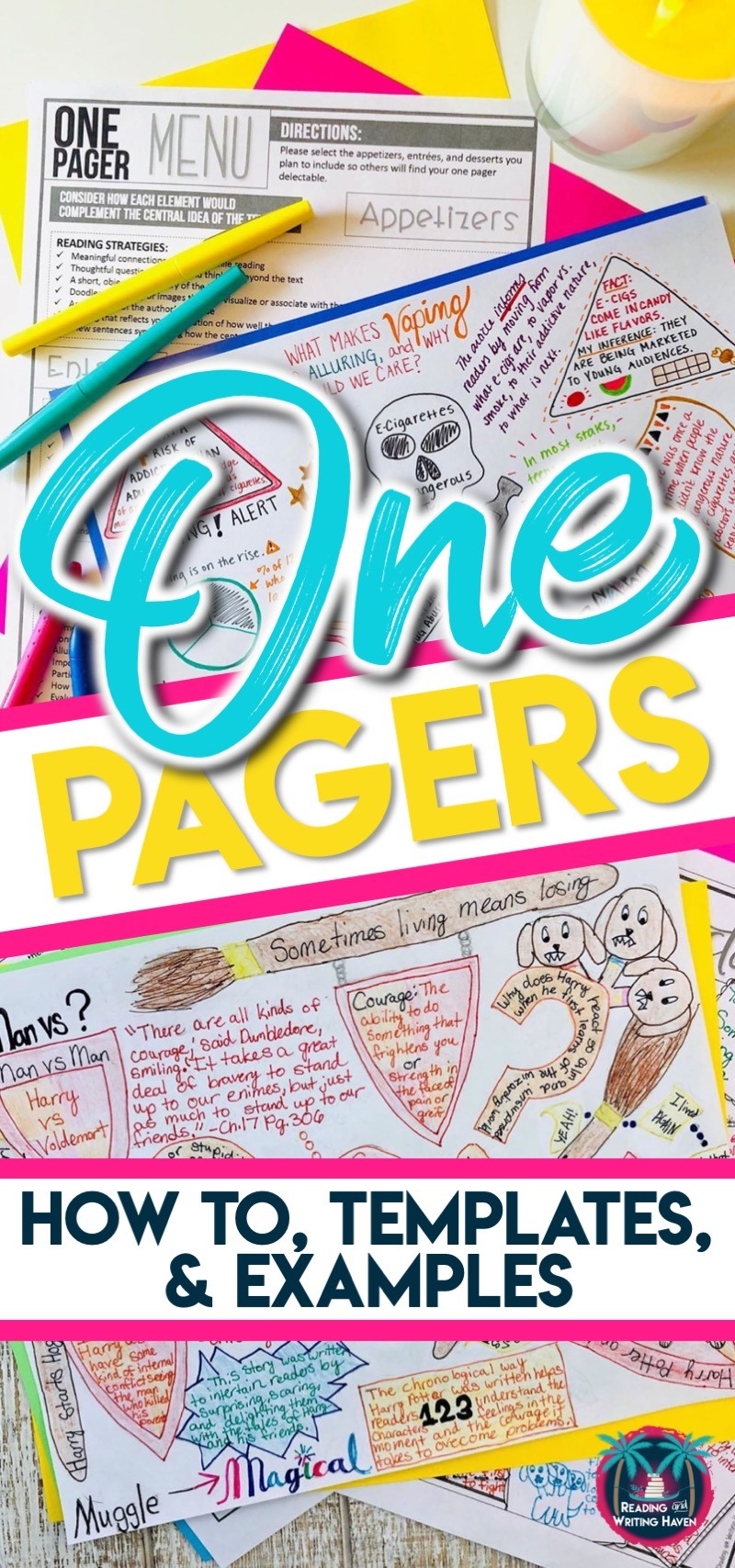
WHAT SHOULD I AVOID WITH A ONE PAGER?
Creating too few or too many guidelines..
It’s important to think about the age of your students. Most middle school students need structure and guidance; students who are not used to thinking from an abstract angle can struggle. Because one pagers are not concrete, teachers need to be specific in their expectations with younger students. High school students who are comfortable with creative thinking and who are used to coloring outside the lines thrive with less scaffolding.
GRADING ON ARTISTIC ABILITY.
It can be easy to get caught up in beautiful one pagers. If you’ve ever made one yourself, you understand how difficult they really are. It’s important to encourage students for their creative thought process – not their creative drawings or beautiful coloring.
DESIGNING RUBRICS BASED ON EFFORT.
With creative assignments, it’s important to validate students’ thinking. When we design rubrics based off of perceived effort, we undermine the content students create. A one pager rubric should reflect skills that are tangible and measurable. For example, I would not include a category for “Effort.” Instead, I would include a category for “Content.” Within that category, it would be reasonable to ask students to cover the page with their reflection on the text. It’s something you can measure. Either the page is covered, or it’s not. Effort, on the other hand, is much more difficult to grade objectively.
USING IT TO “PROVE READING”.
Like most reading projects, one pagers don’t “prove” students have read something. Granted, it’s extremely difficult to create an exemplary one pager without a solid understanding of a text. Still, when I assign one pagers, it’s because I want to see how students are analyzing and synthesizing a text. I use them as a way to measure learning toward standards…not a way to force reading. If you are concerned students aren’t reading a text, the best thing you can do is to confer with them as regularly as possible.
UNDERESTIMATING THE TIME THEY TAKE.
Creating an inspiring one pager takes time. If you’ve never tried to make one before, I encourage you to take on the task before assigning it to students. The first time I did this I was struck by two facts: mine was terrible …and it took way longer than I expected . I still believe they are worth the time and energy, but creating my own example gave me better perspective for what I should expect from students. Plus, I understood I needed to provide them more class time than I originally anticipated in order to complete the work.
TIPS FOR ONE PAGER SUCCESS
Complete one yourself. .
Making a one pager was a humbling experience for me. It really gave me insight into my students’ struggles. What was in my head is not what came out on paper. This experience resulted in a more empathetic and appreciative view of the one pagers I graded.
BRAINSTORM WITH STUDENTS.
Come up with a list of expectations for the assignment. Then, with students, brainstorm possible content to include. Secondary students have fabulous ideas and can inspire one another. Plus, discussing possibilities as a group gives teachers the opportunity to identify appropriate content and redirect students if necessary.
ANALYZE EXAMPLES.
It’s hard to visualize a one pager without looking at examples . I google “one pager examples” and display some of the search results on the projector. I’ve also saved some examples to Google Classroom so that students can view them from their iPads. As we study the images, students begin to see how different they are. We note what works and what doesn’t. We talk about examples that exceed expectations and those that don’t.
USE TEMPLATES.
Scaffold students’ experience with one pagers by providing templates. Use the templates to help students brainstorm and make a strategic plan for how they will maximize their space. The first time I assigned a one pager, I made all the mistakes…and found out that students don’t always know what to do with a blank page. That’s when I created these materials , which supported their thinking and led them toward the standards.
DON’T BOX YOURSELF IN.
It’s important that you don’t go into the one pager assignment thinking there are “rules.” There really aren’t! You can be as creative as you want, and students can, too. If they want their one pager to incorporate a mind map or a collage, that works. If you want them to add texture, don’t hesitate. Do you want students to create a one pager that incorporates multiple texts? Awesome! You do you.
USE THE ONE PAGER TO PROMOTE LITERACY.
It’s all about creating a literacy culture. We need secondary students to appreciate reading – to want to read. Providing students with a variety of ways to respond to a text is a way to achieve that goal. Saving the one pager for special occasions will help to ensure students don’t become burnt out with it. If you feel brave, allow students to work in partners to create a collaborative one pager. Many will love the social aspect of responding to reading. Building positive relationships between reading and how we ask students to respond to literature is a huge step in the process of building a community of readers.
RELATED RESOURCE:
One pagers are a valuable tool for any teacher. They should not replace all traditional essays, and they shouldn’t be assigned after every course text, but they are a wonderful alternative when used modestly. This resource contains scaffolded tools for getting started with literary and informational text one pagers .
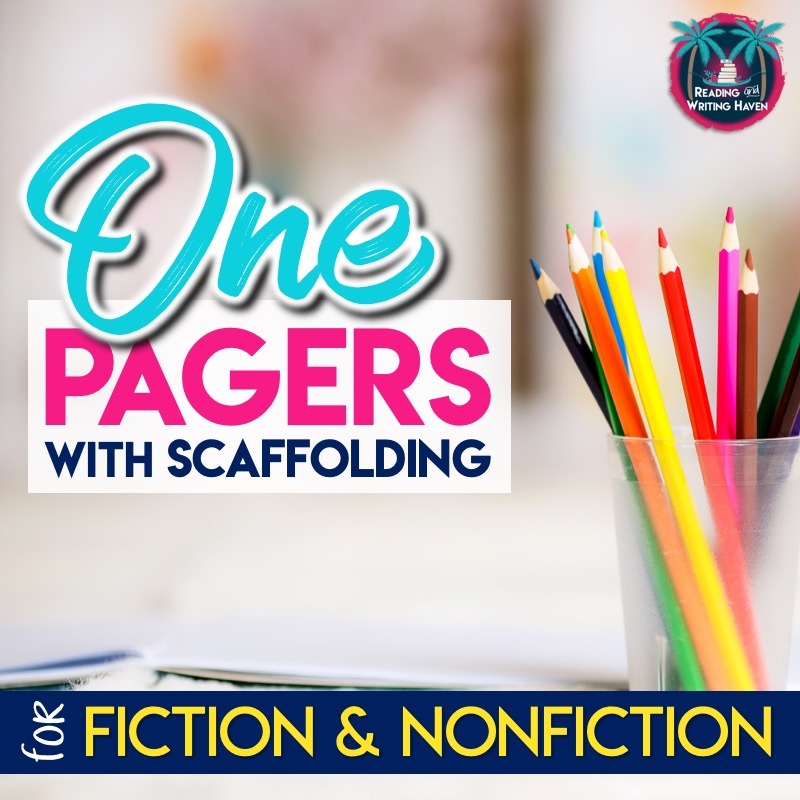
[sc name=”mailchimp1″]
Get the latest in your inbox!

IMAGES
VIDEO
COMMENTS
Rather than just jotting down words on a page, students use one-pagers to visually represent key points and takeaways. They're fun to create and have a real impact on memory and comprehension. Here's how to use them, plus lots of terrific one-pager examples to inspire you and your students.
1. Use one-pagers to help students understand concepts. 2. ... The elements to include in your one-pager depend on the purpose of your assignment or classroom activity. However, effective one-pagers for school students often include the following: Visuals like drawn images, illustrations, or cut-outs from magazines ...
One Pager by a student of Jennifer Anderson-Wagner Jones, Mountain View Middle School Simple Steps for One-Pager Success. Whenever you're considering your options for assessment, throw one-pagers into the mix. The steps below should help you in creating an assignment for which every student has a roadmap to success. 1.
One Pager Directions A one pager is a way to visually share key ideas and information from what you have learned. When you create a one pager, you are trying to use both visual symbols and important words to clearly and concisely share your most important takeaways with someone else. For this one pager, I've provided you with a template.
For the actual assignment, I created a one-pager choice board that is similar that requires students to connect four elements. Every student had to complete the quotes, questions, and images element of the project. From there, students had their choice of four different items they could include: a connection to a song, a timeline, a setting, or ...
Have them compose a one-pager on a music genre, instrument, or artist of their choice. Learn More: Chomping At The Lit. 19. Nature Navigator. Budding botanists are on the loose! Every plant tells a story and using a dynamic one-pager, your students can outline their characteristics, natural habitat, and role in the ecosystem. Learn More: Study ...
What is a one pager assignment? A one pager assignment is an assignment where all of the parts of the task are completed one page. One pager projects can take many different forms. It might be something like a comic book strip (click here for a free template), or it could be a cause-effect chart. It could be a mind map.
Here are the top 25 One-Pager examples: 1. Critical Thinking Math Worksheet: The Odd One Out. The Critical Thinking Math Worksheet: The Odd One Out is a visually engaging and thought-provoking One-Pager designed to challenge students' problem-solving skills. The layout is clean and easy to follow, allowing students to focus on the task at hand.
Respond to a Story in The Times via Our One-Pager Challenge from The NY Times Learning Network has a ton of useful resources. Thinking Made Visible: The Winners of Our One-Pager Contest is from The NY Times Learning Network. Respond to a Story in The Times via Our One-Pager Challenge is from The NY Times Learning Network (2023 version).
USE THE ONE PAGER TO PROMOTE LITERACY. It's all about creating a literacy culture. We need secondary students to appreciate reading - to want to read. Providing students with a variety of ways to respond to a text is a way to achieve that goal. Saving the one pager for special occasions will help to ensure students don't become burnt out ...